O. Reg. 413/05: VEHICLE WEIGHTS AND DIMENSIONS - FOR SAFE, PRODUCTIVE AND INFRASTRUCTURE-FRIENDLY VEHICLES, Highway Traffic Act, R.S.O. 1990, c. H.8
Highway Traffic Act
Code de la route
ONTARIO REGULATION 413/05
VEHICLE WEIGHTS AND DIMENSIONS — FOR SAFE, PRODUCTIVE AND INFRASTRUCTURE-FRIENDLY VEHICLES
Historical version for the period June 28, 2005 to December 8, 2008.
No amendments.
This Regulation is made in English only.
CONTENTS
Application | |
Definitions | |
Designated combinations | |
Alternative designated combinations | |
Preconditions for Vehicle Combinations to be Designated Combinations | |
Liftable axles | |
Rear impact guards | |
Brakes | |
Tires | |
Wheel cut | |
Self-steering axle locking device | |
Tri-drive locking device | |
C-train equipment | |
Semi-trailer labelling | |
Weight requirements | |
Dimensional limits for long combinations | |
Tire weight limits | |
Axle unit weight limits | |
Front axle weights — designated combinations | |
Axle group weight limits | |
Maximum allowable gross vehicle weight — designated combinations 1-10 | |
Maximum allowable gross vehicle weight — designated combination 11 | |
Maximum allowable gross vehicle weight — designated combination 12 | |
Maximum allowable gross vehicle weight — designated combination 13 | |
Allowable gross vehicle weights | |
Aggregate vehicles | |
Calculation | |
Dump semi-trailers | |
Semi-trailer with three or fewer axles | |
Tank semi-trailer with three or fewer axles | |
Specialized tank semi-trailer with three or fewer axles | |
Semi-trailer with four or more axles | |
A-trains and C-trains | |
B-trains | |
Permits | |
Tractor tandem axle weight increases | |
Buses — dimensions | |
Interpretation for Schedules | |
Designated combination 1 — tractor fixed axle semi-trailer | |
Designated combination 2 — tractor self-steer triaxle semi-trailer | |
Designated combination 3 — tractor self-steer quad semi-trailer | |
Designated combination 4 — tractor self-steer 5-axle semi-trailer (1-3-1) | |
Designated combination 5 — tractor self-steer 5-axle semi-trailer (1-1-3) | |
Designated combination 6 — tractor self-steer 6-axle semi-trailer (1-4-1) | |
Designated combination 7 — tractor self-steer 6-axle semi-trailer (1-1-4) | |
Designated combination 8 — tri-drive tractor fixed axle semi-trailer | |
Designated combination 9 — tri-drive tractor self-steer triaxle semi-trailer | |
Designated combination 10 — tri-drive tractor self-steer quad semi-trailer | |
Designated combination 11 — tractor a-train double trailers | |
Designated combination 12 — tractor b-train double trailers | |
Designated combination 13 — tractor c-train double trailers | |
Allowable gross weight on a vehicle with three axles (kilograms) front axle weight, (kilograms) | |
Allowable gross weight on a vehicle with four axles (kilograms) front axle weight, (kilograms) | |
Allowable gross weight on a vehicle with five axles (kilograms) inter-vehicle-unit distance, less than 2.4 metres (or intra-vehicle-unit distance) front axle weight, (kilograms) | |
Allowable gross weight on a vehicle with five axles (kilograms) inter-vehicle-unit distance, 2.4 metres to less than 2.7 metres (or intra-vehicle-unit distance) front axle weight, (kilograms) | |
Allowable gross weight on a vehicle with five axles (kilograms) inter-vehicle-unit distance, 2.7 metres to less than 3.0 metres (or intra-vehicle-unit distance) front axle weight, (kilograms) | |
Allowable gross weight on a vehicle with five axles (kilograms) inter-vehicle-unit distance, 3.0 metres to less than 3.3 metres (or intra-vehicle-unit distance) front axle weight, (kilograms) | |
Allowable gross weight on a vehicle with five axles (kilograms) inter-vehicle-unit distance, 3.3 metres to less than 3.6 metres (or intra-vehicle-unit distance) front axle weight, (kilograms) | |
Allowable gross weight on a vehicle with five axles (kilograms) inter-vehicle-unit distance, 3.6 metres or more (or intra-vehicle-unit distance) front axle weight, (kilograms) | |
Allowable gross weight on a vehicle with six axles (kilograms) inter-vehicle-unit distance, less than 2.1 metres (or intra-vehicle-unit distance) front axle weight, (kilograms) | |
Allowable gross weight on a vehicle with six axles (kilograms) inter-vehicle-unit distance, 2.1 metres to less than 2.4 metres (or intra-vehicle-unit distance) front axle weight, (kilograms) | |
Allowable gross weight on a vehicle with six axles (kilograms) inter-vehicle-unit distance, 2.4 metres to less than 2.7 metres (or intra-vehicle-unit distance) front axle weight, (kilograms) | |
Allowable gross weight on a vehicle with six axles (kilograms) inter-vehicle-unit distance, 2.7 metres to less than 3.0 metres (or intra-vehicle-unit distance) front axle weight, (kilograms) | |
Allowable gross weight on a vehicle with six axles (kilograms) inter-vehicle-unit distance, 3.0 metres to less than 3.3 metres (or intra-vehicle-unit distance) front axle weight, (kilograms) | |
Allowable gross weight on a vehicle with six axles (kilograms) inter-vehicle-unit distance, 3.3 metres to less than 3.6 metres (or intra-vehicle-unit distance) front axle weight, (kilograms) | |
Allowable gross weight on a vehicle with six axles (kilograms) inter-vehicle-unit distance, 3.6 metres or more (or intra-vehicle-unit distance) front axle weight, (kilograms) | |
Allowable gross weight on a vehicle with seven axles (kilograms) inter-vehicle-unit distance, less than 2.1 metres front axle weight, (kilograms) | |
Allowable gross weight on a vehicle with seven axles (kilograms) inter-vehicle-unit distance, 2.1 metres to less than 2.4 metres front axle weight, (kilograms) | |
Allowable gross weight on a vehicle with seven axles (kilograms) inter-vehicle-unit distance, 2.4 metres to less than 2.7 metres front axle weight, (kilograms) | |
Allowable gross weight on a vehicle with seven axles (kilograms) inter-vehicle-unit distance, 2.7 metres to less than 3.0 metres front axle weight, (kilograms) | |
Allowable gross weight on a vehicle with seven axles (kilograms) inter-vehicle-unit distance, 3.0 metres to less than 3.3 metres front axle weight, (kilograms) | |
Allowable gross weight on a vehicle with seven axles (kilograms) inter-vehicle-unit distance, 3.3 metres to less than 3.6 metres front axle weight, (kilograms) | |
Allowable gross weight on a vehicle with seven axles (kilograms) inter-vehicle-unit distance, 3.6 metres or more front axle weight, (kilograms) | |
Allowable gross weight on a vehicle with eight or more axles (kilograms) inter-vehicle-unit distance, less than 2.1 metres front axle weight, (kilograms) | |
Allowable gross weight on a vehicle with eight or more axles (kilograms) inter-vehicle-unit distance, 2.1 metres to less than 2.4 metres front axle weight, (kilograms) | |
Allowable gross weight on a vehicle with eight or more axles (kilograms) inter-vehicle-unit distance, 2.4 metres to less than 2.7 metres front axle weight, (kilograms) | |
Allowable gross weight on a vehicle with eight or more axles (kilograms) inter-vehicle-unit distance, 2.7 metres to less than 3.0 metres front axle weight, (kilograms) | |
Allowable gross weight on a vehicle with eight or more axles (kilograms) inter-vehicle-unit distance, 3.0 metres to less than 3.3 metres front axle weight, (kilograms) | |
Allowable gross weight on a vehicle with eight or more axles (kilograms) inter-vehicle-unit distance, 3.3 metres to less than 3.6 metres front axle weight, (kilograms) | |
Allowable gross weight on a vehicle with eight or more axles (kilograms) inter-vehicle-unit distance, 3.6 metres or more front axle weight, (kilograms) | |
Application and Interpretation
Application
1. This Regulation sets out dimensional limits for the purposes of section 109 of the Act and weight limits for the purposes of sections 115 to 118 of the Act. O. Reg. 413/05, s. 1.
Definitions
2. (1) The definitions in sections 108 and 114 of the Act apply to this Regulation. O. Reg. 413/05, s. 2 (1).
(2) In this Regulation,
“A-train double” means a vehicle combination composed of a tractor, a semi-trailer and,
(a) a trailer converter dolly that is towed from a single hitch, as shown in Figure 1, on the centre line of the semi-trailer and another semi-trailer, or
(b) a full trailer attached to the semi-trailer as if a trailer converter dolly were used and towed from a single hitch, as shown in Figure 1, on the centre line of the semi-trailer;
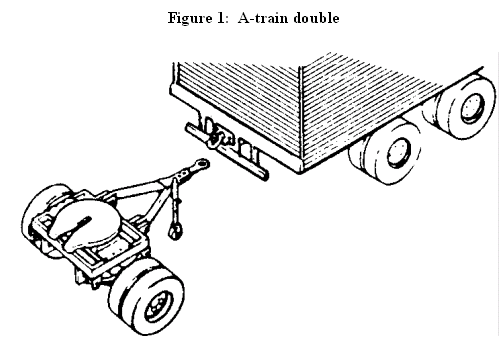
“aggregate vehicle” means a vehicle or vehicle combination that is designed for dumping or spreading sand, gravel, crushed or uncut rock, asphalt, slag or rubble or any mixture of such materials and that is transporting a load consisting mostly of any of these materials;
“axle spread” means the longitudinal distance between the centres of the foremost and rearmost axles of an axle unit;
“B-train double” means a vehicle combination composed of a tractor and two semi-trailers, the rearmost of which is attached by a fifth wheel assembly whose lower half is mounted on the rear of the foremost semi-trailer, as shown in Figure 2;
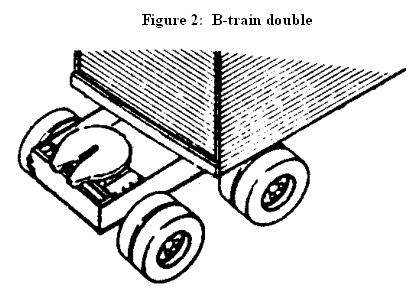
“base length” means the distance measured between the centres of the first axle of the front axle of a vehicle or vehicle combination and the last axle of a vehicle or vehicle combination;
“C-train double” means a vehicle combination consisting of a tractor and two semi-trailers, the second of which is attached to the first by a trailer converter dolly that has a frame rigid in the horizontal plane and that is towed from two hitches located in a horizontal transverse line on the foremost semi-trailer that preclude any rotation in the horizontal plane about the hitch point, as shown in Figure 3;
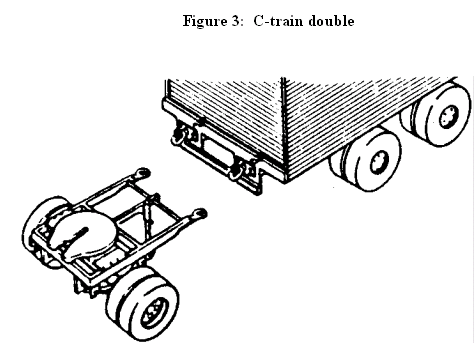
“carbon dioxide tank semi-trailer” means a tank semi-trailer that is used regularly to transport carbon dioxide, was manufactured to Transport Canada specification TC331 or United States Department of Transportation specification MC331 and bears the appropriate specification number on the compliance label or manufacturer’s identification plate affixed to the vehicle;
“cryogenic tank semi-trailer” means a tank semi-trailer that was manufactured to Canadian Gas Association specification CGA341 or Transport Canada specification TC341 and bears the appropriate specification number on the compliance label or manufacturer’s identification plate affixed to the vehicle;
“designated combination”, when followed by a number, means the designated combination identified by the same number in the Table to section 3;
“drawbar” means a towing structure that is connected to the chassis frame of the trailer converter dolly and that includes an eye or equivalent device for coupling to a trailer hitch;
“drive axle” means an axle unit that is connected to the power source of a motor vehicle and that transmits tractive power to the wheels;
“end dump semi-trailer” means a semi-trailer to which is permanently attached a body or box that is hinged and that can be raised to dump from the rear of the semi-trailer;
“fifth wheel assembly” means a plate-type coupling device comprised of a kingpin, locking jaws and plates, the lower half of which is mounted on the rear portion of a vehicle frame or the frame of a trailer converter dolly and the upper half of which is fastened to the underside of the forward portion of a semi-trailer for the purpose of supporting and towing the semi-trailer;
“full trailer” means a trailer designed so that its own weight and any load are carried on its own axles and includes a vehicle combination consisting of a semi-trailer and a trailer converter dolly;
“inter-axle spacing” means the longitudinal distance separating two consecutive axle units within a vehicle or vehicle combination, measured from the centre of the rearmost axle of the foremost axle unit to the centre of the foremost axle of the other axle unit;
“inter-vehicle-unit distance”, for a vehicle combination, means,
(a) the distance between the centres of the last axle of the motor vehicle or road building machine and the first axle of the towed vehicle, and
(b) the distance between the centres of the last axle of the first towed vehicle and the first axle of the second towed vehicle,
but in section 24 and Vehicle Weight Tables 3 to 29, it means the lesser of (a) and (b);
“long combination” means a vehicle combination to which one or more of the following applies:
1. The total length, including load, exceeds the 23 metre limit specified in subsection 109 (7) of the Act.
2. The box length of a combination including more than one trailer exceeds the 18.5 metre limit specified in subsection 109 (8) of the Act.
3. The semi-trailer length, excluding any portion of auxiliary equipment or machinery that extends beyond the front or rear of the semi-trailer and that is not designed or used for the transportation of goods, exceeds the 14.65 metre limit specified in subsection 109 (10) of the Act;
“open-top hopper dump semi-trailer” means a semi-trailer to which is permanently attached an open-top body or box with bottom hoppers that can be opened to dump from the bottom of the semi-trailer;
“quadruple axle” means a four axle group in which the axles,
(a) have their consecutive centres equally spaced,
(b) have their consecutive centres more than one metre apart,
(c) do not include a liftable axle or a self-steering axle,
(d) have the same number of tires at each wheel position, and
(e) are articulated from an attachment to the vehicle common to the consecutive axles or are designed to automatically equalize the load between the four axles under all conditions of loading;
“self-steering axle” means an assembly of two or more wheels whose centres are in one transverse vertical plane and whose wheels can articulate in response to forces generated between the tires and the road or through mechanisms and linkages that operate independently of the driver;
“single semi-trailer” means a semi-trailer that is the only trailer in a tractor-trailer combination;
“tag-axle tank semi-trailer” means a tank semi-trailer,
(a) that is not more than 14.65 metres in length,
(b) that is equipped with a rear single axle and a front tandem axle, whose inter-axle spacing is more than 2.5 metres,
(c) whose single axle,
(i) is a self-steering axle capable of turning 20 degrees in either direction, and
(ii) is not a liftable axle, and
(d) whose axles automatically load equalize;
“tandem axle” means a dual axle as defined in section 114 of the Act that does not include a liftable axle or a self-steering axle and that has the same number of tires at each wheel position;
“tank semi-trailer” means a semi-trailer that is permanently attached to a closed tank having a capacity of 2.3 kilolitres or more;
“tractor” means a commercial motor vehicle designed to draw one or more semi-trailers, or a semi-trailer and a full trailer, to which it is coupled by means of a fifth wheel assembly;
“tridem axle” means a triple axle as defined in section 114 of the Act that does not include a liftable axle or a self-steering axle and that has the same number of tires at each wheel position;
“tri-drive axle” means a drive axle composed of a tridem axle in which each axle of the tridem axle transmits tractive power to its wheels;
“turn centre” means the geometric centre,
(a) on a semi-trailer consisting only of one axle unit, of the axle unit,
(b) on a semi-trailer consisting of more than one axle unit, of the axle unit containing more axles,
(c) on a semi-trailer containing a quadruple axle, of the quadruple axle,
(d) on a tractor or full trailer, of the rear axle unit;
“vehicle combination” means a combination of vehicles. O. Reg. 413/05, s. 2 (2).
(3) For the purposes of this Regulation, where a tire width has been marked on the tire by the manufacturer, the width of the tire shall be deemed to be as marked. O. Reg. 413/05, s. 2 (3).
Designated combinations
3. (1) The Table to this section sets out 13 vehicle combinations that are designated combinations if the vehicle combination meets the configuration description in the correspondingly numbered Schedule, complies with the dimensional limits of that Schedule and also complies with all the relevant preconditions for the designated combination in sections 5 to 14. O. Reg. 413/05, s. 3 (1).
(2) A vehicle combination described in subsection (1) is a designated combination even if it does not meet the weight limits in the corresponding Schedule. O. Reg. 413/05, s. 3 (2).
TABLE OF DESIGNATED COMBINATIONS
1. |
Tractor Fixed Axle Semi-trailer |
2. |
Tractor Self-steer Triaxle Semi-trailer |
3. |
Tractor Self-steer Quad Semi-trailer |
4. |
Tractor Self-steer 5-Axle Semi-trailer (1-3-1) |
5. |
Tractor Self-steer 5-Axle Semi-trailer (1-1-3) |
6. |
Tractor Self-steer 6-Axle Semi-trailer (1-4-1) |
7. |
Tractor Self-steer 6-Axle Semi-trailer (1-1-4) |
8. |
Tri-drive Tractor Fixed Axle Semi-trailer |
9. |
Tri-drive Tractor Self-steer Triaxle Semi-trailer |
10. |
Tri-drive Tractor Self-steer Quad Semi-trailer |
11. |
Tractor A-train Double Trailers |
12. |
Tractor B-train Double Trailers |
13. |
Tractor C-train Double Trailers |
O. Reg. 413/05, s. 3, Table.
Alternative designated combinations
4. (1) A vehicle combination that meets every requirement of subsection 3 (1) to be designated combination 2 except that the self-steering axle of the semi-trailer is not deployed shall be deemed to be designated combination 1. O. Reg. 413/05, s. 4 (1).
(2) A vehicle combination that meets every requirement of subsection 3 (1) to be designated combination 3 except that the self-steering axle of the semi-trailer is not deployed shall be deemed to be designated combination 1. O. Reg. 413/05, s. 4 (2).
(3) A vehicle combination that meets every requirement of subsection 3 (1) to be designated combination 5 except that the front self-steering axle of the semi-trailer is not deployed shall be deemed to be designated combination 3. O. Reg. 413/05, s. 4 (3).
(4) A vehicle combination that meets every requirement of subsection 3 (1) to be designated combination 5 except that both of the self-steering axles of the semi-trailer are not deployed shall be deemed to be designated combination 1. O. Reg. 413/05, s. 4 (4).
(5) A vehicle combination that meets every requirement of subsection 3 (1) to be designated combination 9 except that the self-steering axle of the semi-trailer is not deployed shall be deemed to be designated combination 8. O. Reg. 413/05, s. 4 (5).
(6) A vehicle combination that meets every requirement of subsection 3 (1) to be designated combination 10 except that the self-steering axle of the semi-trailer is not deployed shall be deemed to be designated combination 8. O. Reg. 413/05, s. 4 (6).
Preconditions for Vehicle Combinations to be Designated Combinations
Liftable axles
5. (1) A designated combination may have axles in addition to those specified in the corresponding Schedule, but the additional axles must remain in the raised position. O. Reg. 413/05, s. 5 (1).
(2) The following rules apply to the controls for lifting and deploying self-steering axles in designated combinations 2, 3, 4, 5, 6, 7, 9 and 10:
1. Subject to paragraphs 3 and 4, the tractor must not be equipped with or have controls, whether remote or manual, that would allow the driver to lift or deploy the self-steering axles of the semi-trailer or to alter the weight on the self-steering axles.
2. The semi-trailer must not be equipped with or have controls that would allow the driver to lift or deploy the self-steering axles of the semi-trailer, except for manual controls or for automatic controls that activate only when the combination is reversing.
3. The tractor may be equipped with or have controls that would allow the driver to lift or deploy the self-steering axles of the semi-trailer or to alter the weight on the self-steering axles if the tractor is drawing a semi-trailer designed to carry raw forest products.
4. The tractor may be equipped with or have manual controls that would allow the driver to lift the forward self-steering axle of the semi-trailer or to alter the weight on the forward self-steering axle, but only if,
i. the controls do not activate unless the emergency 4-way flashers are activated, and
ii. the controls contain a device that prevents lifting the axle or altering the axle weight when the combination is travelling at a speed over 60 kilometres per hour. O. Reg. 413/05, s. 5 (2).
(3) In a designated combination 12, the tractor must not be equipped with or have any controls that would allow the driver to lift, deploy or alter the weight of the tridem axle of the lead trailer other than manual controls that would allow the driver to alter the weight on the forward axle of the lead trailer’s tridem axle, but only if,
(a) the controls do not activate unless the emergency 4-way flashers are activated; and
(b) the controls contain a device that prevents altering the axle weight when the combination is travelling at a speed over 60 kilometres per hour. O. Reg. 413/05, s. 5 (3).
(4) In subsection (3) and in Schedule 12,
“tridem axle” means a triple axle as defined in section 114 of the Act that does not include a self-steering axle and that has the same number of tires at each wheel position, and includes an axle unit that is equipped with a device for altering the weight transmitted to the highway surface. O. Reg. 413/05, s. 5 (4).
Rear impact guards
6. (1) The rearmost trailer of any designated combination that is a long combination must be equipped with a rear impact guard meeting the requirements of subsection (2) if,
(a) the trailer was manufactured after July 14, 1993 and before January 27, 1998;
(b) the trailer has an axle unit that can slide or is fixed so that the rear of the rearmost tire is more than 0.3 metres in front of the rear of the trailer; and
(c) the trailer’s rear structure is more than 0.56 metres above the ground when the trailer is unladen on a level surface. O. Reg. 413/05, s. 6 (1).
(2) A rear impact guard, as shown in Figure 4, must consist of a single horizontal beam that is rigidly attached to the trailer and that,
(a) extends within 0.1 metres of each side of the trailer;
(b) is not more than 0.3 metres in front of the rear of the trailer and is as close to the rear as possible; and
(c) is not more than 0.56 metres above the ground when the trailer is unladen on a level surface. O. Reg. 413/05, s. 6 (2).
(3) The rearmost trailer of a combination described in subsection (4) must be equipped with a rear impact guard that meets the standards under United States Federal Motor Vehicle Safety Standard 224 that became effective on January 26, 1998, or a corresponding standard, if any, under the Motor Vehicle Safety Act (Canada). O. Reg. 413/05, s. 6 (3).
(4) Subsection (3) applies to,
(a) any designated combination that is a long combination whose rearmost trailer was manufactured after January 26, 1998;
(b) designated combination 2, 3, 4, 5, 6, 7, 9 or 10; or
(c) any designated combination which includes a trailer that was manufactured after 2005. O. Reg. 413/05, s. 6 (4).
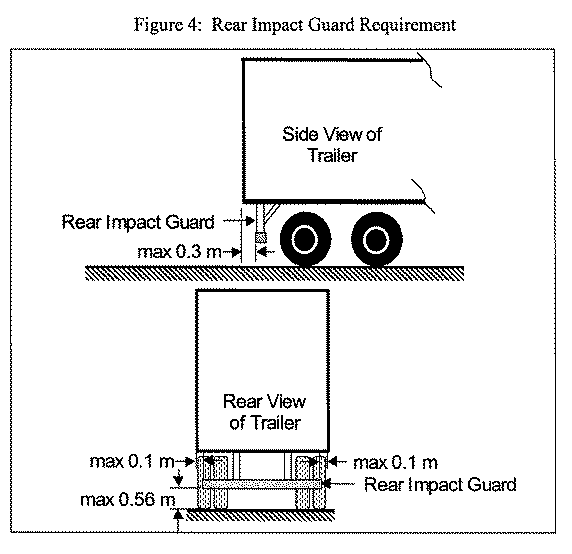
O. Reg. 413/05, s. 6, Figure 4.
Brakes
7. (1) All wheels on all vehicles and trailer converter dollies manufactured after October 19, 1994 that form part of a designated combination that is a long combination must be fitted with a system of automatic brake adjustment and brake adjustment indicators in accordance with United States Federal Motor Vehicle Safety Standard 121 S5.1.8 or S5.2.2, or with the corresponding requirements in Canadian Motor Vehicle Standard 121 that became effective on May 31, 1996. O. Reg. 413/05, s. 7 (1).
(2) Subsection (1) does not apply to wheels on the additional axles described in subsection 5 (1). O. Reg. 413/05, s. 7 (2).
(3) The following brake requirements apply to designated combinations 4, 5, 6 and 7:
1. The semi-trailer service brake system must be constructed so that a single leakage failure in any component of the system, except the tubing or fittings in the control line, does not render the brakes on more than three axles inoperative.
2. The semi-trailer must be equipped with a low air pressure warning system constructed so that, in the event the air pressure in any one of the service brake reservoirs falls below 483 kPa or 70 psi, a red LED warning lamp will illuminate. The lamp must be side-facing, located on the outside of the semi-trailer near the front side marker lamp, within the field of view of the tractor’s rear view mirror, and must include a bulb check feature.
3. The semi-trailer supply and control gladhands must be equipped with screens that will prevent any particle larger than 0.33 millimetres or 0.013 inches from entering the gladhand beyond a point where it remains visible from the opening. A label indicating that the vehicle is equipped with gladhand screens and stating that the gladhand screens must be inspected regularly and kept clean to prevent brake system malfunction must be placed adjacent to the gladhands.
4. The semi-trailer must be equipped with an antilock brake system that directly or indirectly controls each wheel of the semi-trailer.
5. The semi-trailer must display a clearly visible label with the name and telephone number of the semi-trailer manufacturer and the appropriate brake system circuit diagram number. O. Reg. 413/05, s. 7 (3).
Tires
8. The tires of a designated combination must be at least 150 millimetres wide. O. Reg. 413/05, s. 8.
Wheel cut
9. (1) Designated combinations 2, 3, 4, 5, 6, 7, 9 and 10 must comply with the wheel cut requirements of the Table to this section. O. Reg. 413/05, s. 9 (1).
(2) In this section,
“wheel cut” means the number of degrees the wheels of a self-steering axle are capable of turning in either direction from the straight ahead position. O. Reg. 413/05, s. 9 (2).
TABLE
MINIMUM REQUIRED SELF-STEERING AXLE WHEEL CUT
Distance from Turn Centre to Self-steering Axle |
Minimum Degrees of Wheel Cut |
4.65 metres or less |
20° |
More than 4.65 metres and less than or equal to 5.85 metres |
25° |
More than 5.85 metres and less than or equal to 7.10 metres |
28° |
More than 7.10 metres |
30° |
O. Reg. 413/05, s. 9, Table.
Self-steering axle locking device
10. (1) In designated combinations 2 and 9, if the axle spread of the tandem axle of the semi-trailer exceeds 1.85 metres, the designated combination must be equipped with an automatic device that locks the self-steering axle in the straight ahead position when the combination is travelling at a speed over 60 kilometres per hour. O. Reg. 413/05, s. 10 (1).
(2) Designated combinations 4 and 6 must be equipped with an automatic device that locks the rearmost self-steering axle in the straight ahead position when the combination is travelling at a speed over 60 kilometres per hour. O. Reg. 413/05, s. 10 (2).
Tri-drive locking device
11. Any differential locks on a tri-drive axle of a tractor in designated combinations 8, 9 and 10 must remain unlocked while the combination is operated on a highway. O. Reg. 413/05, s. 11.
C-train equipment
12. (1) The foremost semi-trailer of a designated combination 13 must be equipped with a hitch that meets the requirements of section 904 of the Motor Vehicle Safety Regulations made under the Motor Vehicle Safety Act (Canada). O. Reg. 413/05, s. 12 (1).
(2) The trailer converter dolly of a designated combination 13 must be equipped with a drawbar that is not more than two metres long. O. Reg. 413/05, s. 12 (2).
(3) The trailer converter dolly of a designated combination 13 must meet the requirements of section 903 of the Motor Vehicle Safety Regulations made under the Motor Vehicle Safety Act (Canada). O. Reg. 413/05, s. 12 (3).
Semi-trailer labelling
13. (1) The semi-trailer in designated combinations 2, 3, 4, 5, 6, 7, 9 and 10 must bear its original compliance label. O. Reg. 413/05, s. 13 (1).
(2) The semi-trailer’s original compliance label or the manufacturer’s identification plate on the semi-trailer must also contain the notation “SPIF”, signifying that the semi-trailer is safe, productive and infrastructure-friendly and was manufactured to meet the specifications of this Regulation. O. Reg. 413/05, s. 13 (2).
(3) If the semi-trailer was not manufactured to meet the specifications of this Regulation for a designated combination 2, 3, 4, 5, 6, 7, 9 or 10, but was converted to meet such specifications, it must bear a label adjacent to the original compliance label,
(a) containing the notation “SPIF”, signifying that the semi-trailer is safe, productive and infrastructure-friendly and was converted to meet the specifications of this Regulation;
(b) identifying the company, or authorized dealer of a company, under the Motor Vehicle Safety Act (Canada) that converted the semi-trailer; and
(c) indicating the revised gross vehicle and axle weight ratings. O. Reg. 413/05, s. 13 (3).
(4) If the semi-trailer was manufactured or converted before 2006, the label required by subsection (3) may bear the notation “Reg 597 (Ont) – 3” or “Reg 597 (Ont) – 4” instead of the notation “SPIF”. O. Reg. 413/05, s. 13 (4).
Weight requirements
14. (1) A vehicle in a designated combination must not transmit to the highway a weight exceeding the manufacturer’s weight rating for the vehicle. O. Reg. 413/05, s. 14 (1).
(2) A vehicle component, including an axle or a tire, in a designated combination must not transmit to the highway a weight exceeding the manufacturer’s weight rating for the vehicle component. O. Reg. 413/05, s. 14 (2).
(3) Each semi-trailer that forms part of a designated combination must automatically and equally share the load on the axles of the semi-trailer. O. Reg. 413/05, s. 14 (3).
(4) A semi-trailer shall be deemed to not be in compliance with subsection (3) if the weight on any self-steering axle is more than 500 kilograms greater or less than the average weight per axle of the tandem, tridem or quadruple axle of the semi-trailer. O. Reg. 413/05, s. 14 (4).
(5) A semi-trailer forming part of designated combinations 3, 4, 5, 6, 7 and 10 must be equipped with,
(a) a device that accurately displays the total weight on the trailer axles in kilograms; or
(b) a device and a table or chart, from the combined use of which the total weight on the trailer axles in kilograms may be readily and accurately obtained. O. Reg. 413/05, s. 14 (5).
(6) In designated combinations 8, 9 and 10, the front axle weight must be at least 27 per cent of the weight of the tri-drive. O. Reg. 413/05, s. 14 (6).
(7) The sum of weights of the converter dolly axle and the second trailer axles of designated combinations 11 and 13 must not exceed the sum of the weights of the tractor drive axles and the lead semi-trailer axles. O. Reg. 413/05, s. 14 (7).
(8) If the inter-vehicle-unit distance between the trailers of designated combinations 11 and 13 is less than 3 metres, the sum of the weights of the axles on the lead semi-trailer and the trailer converter dolly axle or forward axle of a full trailer must not exceed,
(a) 17,000 kilograms if the axle unit on the lead semi-trailer is a single; or
(b) 23,000 kilograms if the axle unit on the lead semi-trailer is a tandem. O. Reg. 413/05, s. 14 (8).
Rules Applicable to Designated Combinations
Dimensional limits for long combinations
15. (1) Subject to subsection 109 (12) of the Act, a designated combination that is a long combination shall comply with the dimensional limits in the corresponding Schedule and not with the dimensional limits specified in section 109 of the Act, if the dimensional limits in the Schedule are greater than those in section 109 of the Act. O. Reg. 413/05, s. 15 (1).
(2) A long combination that is a designated combination 4, 6 or 7 in every respect except that both self-steering axles are raised shall comply with the dimensional limits in the corresponding Schedule and not with the dimensional limits specified in section 109 of the Act, if the dimensional limits in the Schedule are greater than those in section 109 of the Act and if the gross vehicle weight of the long combination does not exceed the amount permitted under section 118 of the Act and under sections 24 to 31 of this Regulation for a vehicle combination that is not a designated combination. O. Reg. 413/05, s. 15 (2).
Tire weight limits
16. Section 115 of the Act does not apply with respect to the tires of the self-steer axle of designated combinations 3 and 10 if the tires meet the weight limits for tires in the corresponding Schedule. O. Reg. 413/05, s. 16.
Axle unit weight limits
17. The axle unit weight for a designated combination is that specified in the corresponding Schedule instead of the axle unit weight specified or referred to in subsection 116 (1) of the Act. O. Reg. 413/05, s. 17.
Front axle weights — designated combinations
18. The maximum allowable front axle weight in a designated combination is the lowest of the following:
1. The manufacturer’s gross axle weight rating for the axle unit.
2. 5,000 kilograms, if the driver does not have with him or her verification in writing as to the manufacturer’s gross axle weight rating as required by subsection 116 (4) of the Act or does not produce such verification on demand under subsection 116 (5) of the Act.
3. 7,700 kilograms. O. Reg. 413/05, s. 18.
Axle group weight limits
19. The axle group weight for a quadruple axle in a designated combination 6 or 7 is that specified in the corresponding Schedule instead of the axle group weight for a four axle group referred to in clause 117 (1) (c) of the Act. O. Reg. 413/05, s. 19.
Maximum allowable gross vehicle weight — designated combinations 1-10
20. (1) The gross vehicle weight of designated combinations 1 to 10 shall not exceed the lowest of the following:
1. The amount calculated under clause 118 (1) (a) of the Act.
2. The amount calculated under clause 118 (1) (b) of the Act.
3. The maximum allowable gross weight determined under section 24 of this Regulation. O. Reg. 413/05, s. 20 (1).
(2) The front axle weight for the purpose of the calculations in subsection (1) shall be the lesser of the actual axle weight and the maximum allowable front axle weight determined under section 18. O. Reg. 413/05, s. 20 (2).
(3) The axle weights, other than the front axle weight, for the purpose of the calculations in paragraphs 1 and 2 of subsection (1) shall be the maximum allowable axle weights set out in the corresponding Schedule. O. Reg. 413/05, s. 20 (3).
(4) Despite subsection 14 (4), in calculating maximum gross vehicle weights under paragraphs 1 and 2 of subsection (1), the maximum allowable weight for a self-steering axle shall be the average weight per axle calculated by dividing the maximum allowable weight of the tandem, tridem or quadruple axle of the semi-trailer by the number of axles in the tandem, tridem or quadruple axle. O. Reg. 413/05, s. 20 (4).
Maximum allowable gross vehicle weight — designated combination 11
21. (1) If a designated combination 11 is a long combination or at least one of its trailers is manufactured after 2005, its gross vehicle weight shall not exceed the lowest of the following:
1. The amount calculated under clause 118 (1) (a) of the Act.
2. The maximum allowable gross weight determined under section 24 of this Regulation.
3. 41,900 kilograms, if there are five axles.
4. 49,800 kilograms, if there are six axles.
5. 53,500 kilograms, if there are seven or eight axles. O. Reg. 413/05, s. 21 (1).
(2) If a designated combination 11 is not a long combination and both of its trailers are manufactured before 2006, its gross vehicle weight shall not exceed the lesser of the following:
1. The amount calculated under clause 118 (1) (a) of the Act.
2. The maximum allowable gross weight determined under section 24 of this Regulation. O. Reg. 413/05, s. 21 (2).
(3) The front axle weight for the purposes of subsection (1) shall be the lowest of the actual front axle weight, the maximum allowable front axle weight determined under section 18 and 5,499 kilograms. O. Reg. 413/05, s. 21 (3).
(4) The front axle weight for the purposes of subsection (2) shall be the lesser of the actual front axle weight and the maximum allowable front axle weight determined under section 18. O. Reg. 413/05, s. 21 (4).
(5) The axle weights, other than the front axle weight, for the purposes of the calculations in paragraph 1 of subsection (1) and paragraph 1 of subsection (2) shall be the maximum allowable axle weights in Schedule 11. O. Reg. 413/05, s. 21 (5).
Maximum allowable gross vehicle weight — designated combination 12
22. (1) If a designated combination 12 is a long combination or if at least one its trailers is manufactured after 2005, its gross vehicle weight shall not exceed the lesser of the amount calculated under clause 118 (1) (a) of the Act and the following:
1. The maximum allowable gross weight determined under section 24 of this Regulation, if the designated combination has less than seven axles.
2. The maximum allowable gross vehicle weight determined under Table A to this section, if the designated combination has seven axles.
3. The maximum allowable gross vehicle weight determined under Table B to this section, if the designated combination has eight or nine axles. O. Reg. 413/05, s. 22 (1).
(2) If a designated combination 12 is not a long combination and both of its trailers are manufactured before 2006, its gross vehicle weight shall not exceed the lesser of the following:
1. The amount calculated under clause 118 (1) (a) of the Act.
2. The maximum allowable gross weight determined under section 24 of this Regulation. O. Reg. 413/05, s. 22 (2).
(3) The front axle weight for the purposes of subsections (1) and (2) shall be the lesser of the actual axle weight and the maximum allowable front axle weight determined under section 18. O. Reg. 413/05, s. 22 (3).
(4) The axle weights, other than the front axle weight, for the purpose of the calculation under clause 118 (1) (a) of the Act in subsections (1) and (2), shall be the maximum allowable axle weights in Schedule 12. O. Reg. 413/05, s. 22 (4).
TABLE A
ALLOWABLE GROSS WEIGHT ON A B-TRAIN WITH 7 AXLES
Base Length (metres) |
Front Axle Weight (kilograms) | |
5,000 or less |
5,001 to and including 7,700 | |
Less than 17.00 |
55,900 |
56,500 |
17.00 to less than 17.25 |
56,300 |
56,600 |
17.25 to less than 17.50 |
56,700 |
57,000 |
17.50 to less than 17.75 |
57,100 |
57,400 |
17.75 to less than 18.00 |
57,500 |
57,800 |
18.00 to less than 18.25 |
57,900 |
58,200 |
18.25 to less than 18.50 |
58,400 |
58,600 |
18.50 to less than 18.75 |
58,800 |
59,000 |
18.75 to less than 19.00 |
59,300 |
59,500 |
19.00 to less than 19.25 |
59,700 |
59,900 |
19.25 and over |
60,100 |
60,300 |
O. Reg. 413/05, s. 22, Table A.
TABLE B
ALLOWABLE GROSS WEIGHT ON A B-TRAIN WITH 8 OR 9 AXLES
Base Length (metres) |
Front Axle Weight (kilograms) | |
5,000 or less |
5,001 to and including 7,700 | |
Less than 19.00 |
60,600 |
61,000 |
19.00 to less than 19.25 |
61,100 |
61,400 |
19.25 to less than 19.40 |
61,500 |
61,800 |
19.40 to less than 19.75 |
61,700 |
62,500 |
19.75 to less than 20.00 |
62,100 |
62,900 |
20.00 to less than 20.25 |
62,300 |
63,100 |
20.25 to less than 20.50 |
62,600 |
63,300 |
20.50 to less than 20.75 |
62,900 |
63,500 |
20.75 to less than 21.00 |
63,100 |
63,500 |
21.00 to less than 21.25 |
63,300 |
63,500 |
21.25 and over |
63,500 |
63,500 |
O. Reg. 413/05, s. 22, Table B.
Maximum allowable gross vehicle weight — designated combination 13
23. (1) If a designated combination 13 is a long combination or if at least one of its trailers is manufactured after 2005, its gross vehicle weight shall not exceed the lowest of the following:
1. The amount calculated under clause 118 (1) (a) of the Act.
2. The maximum allowable gross weight determined under section 24 of this Regulation.
3. If there are five axles, 41,900 kilograms.
4. If there are six axles, 49,800 kilograms.
5. If there are seven axles, 54,600 kilograms.
6. If there are eight axles, 58,500 kilograms. O. Reg. 413/05, s. 23 (1).
(2) If a designated combination 13 is not a long combination and both of its trailers are manufactured before 2006, its gross vehicle weight shall not exceed the lesser of the following:
1. The amount calculated under clause 118 (1) (a) of the Act.
2. The maximum allowable gross weight determined under section 24 of this Regulation. O. Reg. 413/05, s. 23 (2).
(3) The front axle weight for the purposes of the calculations in subsection (1) is the lowest of the actual front axle weight, the maximum allowable front axle weight determined under section 18 and 5,499 kilograms. O. Reg. 413/05, s. 23 (3).
(4) The front axle weight for the purposes of the calculations in subsection (2) is the lesser of the actual front axle weight and the maximum allowable front axle weight determined under section 18. O. Reg. 413/05, s. 23 (4).
(5) The axle weights, other than the front axle weight, for the purposes of the calculations in paragraph 1 of subsection (1) and paragraph 1 of subsection (2) are the maximum allowable weights in Schedule 13. O. Reg. 413/05, s. 23 (5).
Maximum Allowable Gross Vehicle Weights for Designated Combinations and Other Vehicles and Vehicle Combinations
Allowable gross vehicle weights
24. (1) For the purposes of section 118 of the Act, the maximum allowable gross weight for a vehicle or a vehicle combination is as follows:
1. If the vehicle or vehicle combination has three axles, as prescribed in Vehicle Weight Table 1.
2. If the vehicle or vehicle combination has four axles, as prescribed in Vehicle Weight Table 2.
3. If the vehicle or vehicle combination has five axles and an inter-vehicle-unit distance or intra-vehicle-unit distance of less than 2.40 metres, as prescribed in Vehicle Weight Table 3.
4. If the vehicle or vehicle combination has five axles and an inter-vehicle-unit distance or intra-vehicle-unit distance of 2.40 metres or more and less than 2.70 metres, as prescribed in Vehicle Weight Table 4.
5. If the vehicle or vehicle combination has five axles and an inter-vehicle-unit distance or intra-vehicle-unit distance of 2.70 metres or more and less than 3.00 metres, as prescribed in Vehicle Weight Table 5.
6. If the vehicle or vehicle combination has five axles and an inter-vehicle-unit distance or intra-vehicle-unit distance of 3.00 metres or more and less than 3.30 metres, as prescribed in Vehicle Weight Table 6.
7. If the vehicle or vehicle combination has five axles and an inter-vehicle-unit distance or intra-vehicle-unit distance of 3.30 metres or more and less than 3.60 metres, as prescribed in Vehicle Weight Table 7.
8. If the vehicle or vehicle combination has five axles and an inter-vehicle-unit distance or intra-vehicle-unit distance of 3.60 metres or more, as prescribed in Vehicle Weight Table 8.
9. If the vehicle or vehicle combination has six axles and an inter-vehicle-unit distance or intra-vehicle-unit distance of less than 2.10 metres, as prescribed in Vehicle Weight Table 9.
10. If the vehicle or vehicle combination has six axles and an inter-vehicle-unit distance or intra-vehicle-unit distance of 2.10 metres or more and less than 2.40 metres, as prescribed in Vehicle Weight Table 10.
11. If the vehicle or vehicle combination has six axles and an inter-vehicle-unit distance or intra-vehicle-unit distance of 2.40 metres or more and less than 2.70 metres, as prescribed in Vehicle Weight Table 11.
12. If the vehicle or vehicle combination has six axles and an inter-vehicle-unit distance or intra-vehicle-unit distance of 2.70 metres or more and less than 3.00 metres, as prescribed in Vehicle Weight Table 12.
13. If the vehicle or vehicle combination has six axles and an inter-vehicle-unit distance or intra-vehicle-unit distance of 3.00 metres or more and less than 3.30 metres, as prescribed in Vehicle Weight Table 13.
14. If the vehicle or vehicle combination has six axles and an inter-vehicle-unit distance or intra-vehicle-unit distance of 3.30 metres or more and less than 3.60 metres, as prescribed in Vehicle Weight Table 14.
15. If the vehicle or vehicle combination has six axles and an inter-vehicle-unit distance or intra-vehicle-unit distance of 3.60 metres or more, as prescribed in Vehicle Weight Table 15.
16. If the vehicle or vehicle combination has seven axles and an inter-vehicle-unit distance of less than 2.10 metres, as prescribed in Vehicle Weight Table 16.
17. If the vehicle or vehicle combination has seven axles and an inter-vehicle-unit distance of 2.10 metres or more and less than 2.40 metres, as prescribed in Vehicle Weight Table 17.
18. If the vehicle or vehicle combination has seven axles and an inter-vehicle-unit distance of 2.40 metres or more and less than 2.70 metres, as prescribed in Vehicle Weight Table 18.
19. If the vehicle or vehicle combination has seven axles and an inter-vehicle-unit distance of 2.70 metres or more and less than 3.00 metres, as prescribed in Vehicle Weight Table 19.
20. If the vehicle or vehicle combination has seven axles and an inter-vehicle-unit distance of 3.00 metres or more and less than 3.30 metres, as prescribed in Vehicle Weight Table 20.
21. If the vehicle or vehicle combination has seven axles and an inter-vehicle-unit distance of 3.30 metres or more and less than 3.60 metres, as prescribed in Vehicle Weight Table 21.
22. If the vehicle or vehicle combination has seven axles and an inter-vehicle-unit distance of 3.60 metres or more, as prescribed in Vehicle Weight Table 22.
23. If the vehicle or vehicle combination has eight or more axles and an inter-vehicle-unit distance of less than 2.10 metres, as prescribed in Vehicle Weight Table 23.
24. If the vehicle or vehicle combination has eight or more axles and an inter-vehicle-unit distance of 2.10 metres or more and less than 2.40 metres, as prescribed in Vehicle Weight Table 24.
25. If the vehicle or vehicle combination has eight or more axles and an inter-vehicle-unit distance of 2.40 metres or more and less than 2.70 metres, as prescribed in Vehicle Weight Table 25.
26. If the vehicle or vehicle combination has eight or more axles and an inter-vehicle-unit distance of 2.70 metres or more and less than 3.00 metres, as prescribed in Vehicle Weight Table 26.
27. If the vehicle or vehicle combination has eight or more axles and an inter-vehicle-unit distance of 3.00 metres or more and less than 3.30 metres, as prescribed in Vehicle Weight Table 27.
28. If the vehicle or vehicle combination has eight or more axles and an inter-vehicle-unit distance of 3.30 metres or more and less than 3.60 metres, as prescribed in Vehicle Weight Table 28.
29. If the vehicle or vehicle combination has eight or more axles and an inter-vehicle-unit distance of 3.60 metres or more, as prescribed in Vehicle Weight Table 29. O. Reg. 413/05, s. 24 (1).
(2) Despite paragraphs 3 to 8 of subsection (1), the maximum allowable gross vehicle weight for a 5-axle A-train double or C-train double is as prescribed in Vehicle Weight Table 8. O. Reg. 413/05, s. 24 (2).
(3) Despite paragraphs 16 to 22 of subsection (1), the maximum allowable gross vehicle weight for a seven axle vehicle without a towed vehicle is as prescribed in Vehicle Weight Table 16. O. Reg. 413/05, s. 24 (3).
(4) Despite paragraphs 23 to 29 of subsection (1), the maximum allowable gross vehicle weight for an eight or more axle vehicle without a towed vehicle is as prescribed in Vehicle Weight Table 23. O. Reg. 413/05, s. 24 (4).
(5) If the gross weight transmitted to the highway by the rearmost vehicle of a vehicle combination is not at least five per cent of the gross weight of the vehicle combination, the axles of the rearmost vehicle are not included in calculating the base length and the number of axles when determining the maximum allowable gross weight of the combination under subsection (1), but the gross weight of the rearmost vehicle is added to the maximum allowable gross weight of the combination, as determined by the applicable table. O. Reg. 413/05, s. 24 (5).
(6) If the calculation for the maximum allowable gross weight to which subsection (5) applies produces a result greater than 63,500 kilograms, the maximum allowable gross weight is 63,500 kilograms. O. Reg. 413/05, s. 24 (6).
(7) In this section,
“intra-vehicle-unit distance”, for a five or six axle vehicle without a towed vehicle, means the greater of,
(a) the distance between the centres of the second and third axles from the front of the vehicle, and
(b) the distance between the centres of the third and fourth axles from the front of the vehicle;
“number of axles” means the total number of axles on a vehicle or vehicle combination that are transmitting weight to the highway. O. Reg. 413/05, s. 24 (7).
(8) In the Vehicle Weight Tables referred to in this section,
“front axle weight”, in respect of a vehicle or vehicle combination that is not a designated combination or an aggregate vehicle, means,
(a) for a single front axle, the axle unit weight on the front axle or, if that weight is more than the maximum weight permitted for a single axle under section 116 of the Act, the maximum weight permitted for a single axle under section 116 of the Act,
(b) for a dual front axle, one-half of the axle unit weight on the dual front axle or, if that weight is more than one-half of the maximum weight permitted for a dual axle under section 116 of the Act, one-half of the maximum weight permitted for a dual axle under section 116 of the Act, and
(c) for a triple front axle, one-third of the axle unit weight for the triple front axle or, if that weight is more than one-third of the maximum weight permitted for a triple axle under section 116 of the Act, one-third of the maximum weight permitted for a triple axle under section 116 of the Act. O. Reg. 413/05, s. 24 (8).
Weight Reductions — Non-Designated Combinations
Aggregate vehicles
25. (1) This section does not apply to a designated combination. O. Reg. 413/05, s. 25 (1).
(2) Aggregate vehicles are exempt from clauses 118 (1) (a) and (b) of the Act. O. Reg. 413/05, s. 25 (2).
(3) An aggregate vehicle shall not be operated on a Class A Highway if the gross vehicle weight exceeds, in the case of a two axle aggregate vehicle, the result when 1,000 kilograms is subtracted from, or, in the case of an aggregate vehicle of three or more axles, the result when 1,500 kilograms is subtracted from,
(a) the maximum weight permitted on the front axle under section 116 of the Act plus the sum of the maximum allowable weights for all other axle units of the vehicle or vehicle combination as set out in section 116 of the Act;
(b) the maximum weight permitted on the front axle under section 116 of the Act plus the sum of the maximum allowable weights for any two axle groups, three axle groups or four axle groups, or any combination of them, as set out in section 117 of the Act, plus the maximum allowable weight for any axle unit or units excluding any axle unit or units that are part of an axle group, as set out in section 116 of the Act; or
(c) the maximum allowable gross weight prescribed in section 24 of this Regulation. O. Reg. 413/05, s. 25 (3).
(4) Where the calculation of front axle weight for an aggregate vehicle powered by a tractor results in a weight over 6,500 kilograms, the front axle weight shall be deemed to be 6,500 kilograms. O. Reg. 413/05, s. 25 (4).
(5) In this section,
“front axle weight”, in respect of an aggregate vehicle, means,
(a) for a single front axle, the maximum weight permitted under section 116 of the Act for a single axle, and
(b) for a dual front axle, one-half the maximum weight permitted under section 116 of the Act for a dual axle. O. Reg. 413/05, s. 25 (5).
Calculation
26. (1) For combinations of vehicles to which one of sections 27 to 34 of this Regulation applies, maximum allowable gross vehicle weights for the purposes of section 118 of the Act shall be determined by subtracting the amounts in section 27, 28, 29, 30, 31, 32, 33 or 34, as applicable, from the lowest of the following amounts:
1. The amount calculated under clause 118 (1) (a) of the Act.
2. The amount calculated under clause 118 (1) (b) of the Act.
3. The maximum allowable gross weight prescribed in section 24 of this Regulation. O. Reg. 413/05, s. 26 (1).
(2) For combinations of vehicles to which both section 25 and one of sections 27 to 34 of this Regulation apply, maximum allowable gross vehicle weights for the purposes of section 118 of the Act shall be determined by subtracting the amounts in section 27, 28, 29, 30, 31, 32, 33 or 34, as applicable, from the amount permitted under section 25 of this Regulation. O. Reg. 413/05, s. 26 (2).
Dump semi-trailers
27. (1) Until December 31, 2010, 4,500 kilograms shall be subtracted when the vehicle combination includes a single end dump semi-trailer or open-top hopper dump semi-trailer manufactured after 2002 unless the combination is one of designated combinations 1 to 10. O. Reg. 413/05, s. 27 (1).
(2) Effective January 1, 2011, 4,500 kilograms shall be subtracted when the vehicle combination includes a single end dump semi-trailer or open-top hopper dump semi-trailer, whenever it was manufactured, unless the combination is one of designated combinations 1 to 10. O. Reg. 413/05, s. 27 (2).
(3) Where two or more liftable axles are deployed in a vehicle combination to which subsection (1) or (2) applies, 9,000 kilograms shall be subtracted under that subsection instead of 4,500 kilograms. O. Reg. 413/05, s. 27 (3).
Semi-trailer with three or fewer axles
28. (1) This section applies to vehicle combinations that include a single semi-trailer that has three or fewer axles deployed unless it is a designated combination 1, 2, 8 or 9, if the semi-trailer is not,
(a) an open-top hopper dump semi-trailer;
(b) an end dump semi-trailer; or
(c) any type of tank semi-trailer. O. Reg. 413/05, s. 28 (1).
(2) From January 1, 2006 to December 31, 2010, 3,000 kilograms shall be subtracted from a combination to which this section applies. O. Reg. 413/05, s. 28 (2).
(3) Effective January 1, 2011, 4,500 kilograms shall be subtracted from a combination to which this section applies. O. Reg. 413/05, s. 28 (3).
Tank semi-trailer with three or fewer axles
29. (1) This section applies to vehicle combinations that include a single semi-trailer that has three or fewer axles deployed unless it is a designated combination 1, 2, 8 or 9, if the semi-trailer is a tank semi-trailer, other than,
(a) a carbon dioxide tank semi-trailer;
(b) a cryogenic tank semi-trailer; or
(c) a tag-axle tank semi-trailer. O. Reg. 413/05, s. 29 (1).
(2) From January 1, 2006 to December 31, 2020, 3,000 kilograms shall be subtracted from a combination to which this section applies. O. Reg. 413/05, s. 29 (2).
(3) Effective January 1, 2021, 4,500 kilograms shall be subtracted from a combination to which this section applies. O. Reg. 413/05, s. 29 (3).
Specialized tank semi-trailer with three or fewer axles
30. (1) This section applies to vehicle combinations that include a single semi-trailer that has three or fewer axles deployed unless it is a designated combination 1, 2, 8 or 9, if the semi-trailer is,
(a) a carbon dioxide tank semi-trailer;
(b) a cryogenic tank semi-trailer; or
(c) a tag-axle tank semi-trailer. O. Reg. 413/05, s. 30 (1).
(2) Effective January 1, 2021, 4,500 kilograms shall be subtracted from a combination to which this section applies. O. Reg. 413/05, s. 30 (2).
Semi-trailer with four or more axles
31. (1) This section applies to vehicle combinations that include a single semi-trailer that has four or more deployed axles unless it is a designated combination 3, 4, 5, 6, 7 or 10, if the semi-trailer is not,
(a) an end dump semi-trailer; or
(b) an open-top hopper dump semi-trailer. O. Reg. 413/05, s. 31 (1).
(2) From January 1, 2006 to December 31, 2015, 4,500 kilograms shall be subtracted if the semi-trailer is manufactured after 2005. O. Reg. 413/05, s. 31 (2).
(3) Effective January 1, 2016, 4,500 kilograms shall be subtracted, whenever the semi-trailer was manufactured. O. Reg. 413/05, s. 31 (3).
(4) Where two or more liftable axles are deployed in a vehicle combination to which this section applies, 9,000 kilograms shall be subtracted under subsection (2) or (3) instead of 4,500 kilograms. O. Reg. 413/05, s. 31 (4).
A-trains and C-trains
32. (1) From January 1, 2006 to December 31, 2015, 9,000 kilograms shall be subtracted when the vehicle combination is an A-Train double or C-Train double that is not a designated combination 11 or 13, if either trailer is manufactured after 2005. O. Reg. 413/05, s. 32 (1).
(2) Effective January 1, 2016, 9,000 kilograms shall be subtracted when the vehicle combination is an A-train double or C-train double that is not a designated combination 11 or 13, whenever the trailers were manufactured. O. Reg. 413/05, s. 32 (2).
B-trains
33. (1) From January 1, 2006 to December 31, 2015, 4,500 kilograms shall be subtracted when the vehicle combination is a B-train double that is not a designated combination 12 if either semi-trailer is manufactured after 2005. O. Reg. 413/05, s. 33 (1).
(2) Effective January 1, 2016, 4,500 kilograms shall be subtracted when the vehicle combination is a B-train double if the combination is not a designated combination 12, whenever the trailers were manufactured. O. Reg. 413/05, s. 33 (2).
(3) Where two or more liftable axles are deployed on a vehicle combination to which subsection (1) or (2) applies, 9,000 kilograms shall be subtracted under the applicable subsection instead of 4,500 kilograms. O. Reg. 413/05, s. 33 (3).
Permits
34. (1) The Registrar may issue a permit under clause 110.1 (1) (b) of the Act,
(a) allowing an end-dump semi-trailer or open-top hopper dump semi-trailer manufactured before January 1, 2003 that would otherwise be subject to subsection 27 (2) or (3) of this Regulation to operate after January 1, 2011 without complying with those subsections;
(b) allowing a single semi-trailer with four or more deployed axles manufactured before January 1, 2006 that would otherwise be subject to subsection 31 (3) or (4) of this Regulation to operate after January 1, 2016 without complying with that subsection;
(c) allowing a combination that is an A-train double, B-train double or C-train double that includes two trailers manufactured before 2006 that would otherwise be subject to subsection 32 (2) or 33 (2) or (3) of this Regulation to operated after January 1, 2016 without complying with those subsections. O. Reg. 413/05, s. 34 (1).
(2) A permit described in clause (1) (a) may be issued for the purpose of allowing the continued use of a semi-trailer that was manufactured before 2003, but such permit shall be limited to the normal operating life of the semi-trailer and so may only allow be valid,
(a) in the case of an end dump semi-trailer, for 15 years after the year of its manufacture;
(b) in the case of an open-top hopper dump semi-trailer, for 20 years after the year of its manufacture. O. Reg. 413/05, s. 34 (2).
(3) A permit described in clause (1) (b) may be issued for the purpose of allowing the continued use of a semi-trailer that was manufactured before 2006, but such permit shall be limited to the normal operating life of the semi-trailer and so may only be valid,
(a) in the case of a semi-trailer, other than a tank semi-trailer, for 15 years after the year of its manufacture;
(b) in the case of a tank semi-trailer, for 20 years after the year of its manufacture. O. Reg. 413/05, s. 34 (3).
(4) A permit described in clause (1) (c) may be issued for the purpose of allowing the continued use of a semi-trailer that was manufactured before 2006 in a combination consisting of an A-train double, B-train double or C-train double, but such permit shall be limited to the normal operating life of the semi-trailer and so may only be valid,
(a) in the case of a semi-trailer, other than a tank semi-trailer, for 15 years after the year of its manufacture;
(b) in the case of a tank semi-trailer, for 20 years after the year of its manufacture. O. Reg. 413/05, s. 34 (4).
Tractor tandem axle weight increases
35. (1) Tandem axles with an axle spread of at least 1.2 metres and less than 1.6 metres are prescribed axle units for the purposes of section 116 of the Act when they form part of a three axle tractor that has both a front single axle equipped with single tires and a rear tandem axle, and that has no other axles deployed. O. Reg. 413/05, s. 35 (1).
(2) Instead of the maximum allowable axle unit weights specified in Table 1 of Part VIII of the Act, the prescribed weight for the axle units prescribed in subsection (1) is 18,000 kilograms. O. Reg. 413/05, s. 35 (2).
Buses — dimensions
36. (1) A bus, as shown in Figure 5 and commonly known as an intercity motor coach, is exempt from any provision in section 109 of the Act specifying a lesser dimension than that specified in this section if the bus is equipped with motive power mounted to the rear of the front axle, air-ride or torsion-bar suspension, reclining seats and a baggage area that is separated from the passenger cabin. O. Reg. 413/05, s. 36 (1).
(2) The total length of the bus, including bumpers, shall not exceed 14 metres. O. Reg. 413/05, s. 36 (2).
(3) The bus shall have three axles and any tandem axle or two axle group shall have an axle spread of 1.2 to 1.85 metres. O. Reg. 413/05, s. 36 (3).
(4) The longitudinal distance between the geometric centre of a dual axle or a two axle group and the rear of the bus, including bumpers, shall not exceed four metres. O. Reg. 413/05, s. 36 (4).
(5) Any two axle group shall distribute the load it carries between the axles in a ratio corresponding to the number of tires on each axle. O. Reg. 413/05, s. 36 (5).
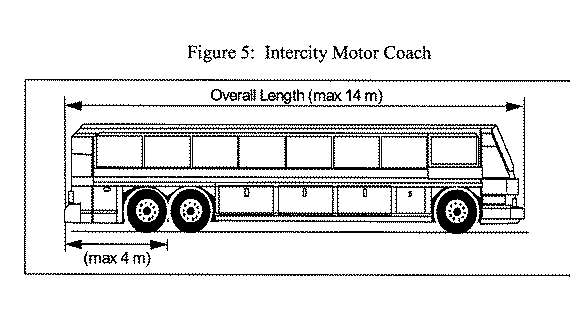
O. Reg. 413/05, s. 36, Figure 5.
Schedules of Designated Combinations
Interpretation for Schedules
37. (1) The following interpretive rules apply to Schedules 1 to 13:
1. The column heading “Ref” means points of reference in the diagram at the top of the Schedule and the entries in that column are to the dimensions identified in the diagram.
2. A reference to an axle unit in a Configuration Description is to a deployed axle unit. If an axle unit is not referred to in a Configuration Description, the designated combination does not have that axle unit unless it is an additional axle described in subsection 5 (1).
3. Where a tire weight limit is expressed as weight per millimetre, the reference is to a millimetre of tire width.
4. A vehicle that is required to comply with subsection 109 (2) of the Act and which does comply with that subsection shall be deemed to be in compliance with the width limits in Schedules 1 to 13.
5. Maximum width shall be determined in accordance with subsections 109 (1), (3) and (5) of the Act.
6. Maximum semi-trailer length shall be determined in accordance with subsection 109 (10) and (10.2) of the Act.
7. A reference to a table in “HTA, Part VIII” means that the appropriate weight is that set out in the specified Table in Part VIII of the Act.
8. “Not controlled” means that no measurement is prescribed.
9. “Overall” refers to the total combination.
10. The prescribed weight of any axle unit with single tires is the sum of its individual maximum axle weights as specified in the Schedule under Individual Axle with Single Tires when the sum of those weights is less than the weight prescribed elsewhere in the Weight Limit Chart for the axle unit. O. Reg. 413/05, s. 37 (1).
(2) In Schedules 1 to 13,
“bed length” means the external measurement of a trailer from the front of its cargo carrying space to the rear of its cargo carrying space, but excluding any portion of auxiliary equipment or machinery that extends beyond the front of the trailer and that is not designed for the transportation of goods;
“drawbar length” means the longitudinal distance from the centre of the hole in the fifth wheel of a converter dolly to the centre of its eye or equivalent device;
“effective rear overhang” means the longitudinal distance from the turn centre of the trailer to its rearmost point, including any load;
“hitch offset” means the longitudinal distance from the turn centre of the foremost semi-trailer to the articulation point of the hitch used to tow the rearmost trailer;
“kg” means kilograms;
“m” means metres;
“max” means maximum;
“min” means minimum;
“quadruple spread” means the longitudinal distance between the centres of the foremost and rearmost axles of the quadruple axle;
“self-steer” means self-steering axle;
“single” means single axle;
“swing radius” means the greatest horizontal distance from the vertical axis through the centre of the kingpin to any point on the semi-trailer ahead of the kingpin, including load and any extension to the length caused by auxiliary equipment or machinery;
“tandem” means tandem axle;
“track width” means the width of an axle across the outside faces of the tires measured at any point above the lowest point of the rim;
“tridem” means tridem axle;
“tri-drive” means tri-drive axle;
“wheelbase” means the longitudinal distance,
(a) from the centre of the kingpin to the turn centre in the case of a semi-trailer,
(b) from the centre of the front axle to the turn centre in the case of a tractor,
(c) from the centre of articulation of the turntable to the turn centre in the case of a full trailer. O. Reg. 413/05, s. 37 (2).
38. Omitted (revokes other Regulations). O. Reg. 413/05, s. 38.
SCHEDULE 1
DESIGNATED COMBINATION 1 — TRACTOR FIXED AXLE SEMI-TRAILER
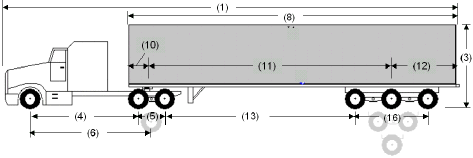
Configuration Description
Designated Combination 1 is composed of a tractor and a single semi-trailer. The front axle of the tractor is a single axle with single tires. The drive axle of the tractor is either a single or tandem axle. The semi-trailer has one axle unit that is either a single, tandem or tridem axle.
Qualifying Preconditions
Weight, see s. 14
Equipment and components, see ss. 5 to 8
DIMENSIONAL LIMIT CHART
Ref |
Feature |
Dimensional Limit | |
Overall |
(1) |
Overall Length |
Max. 23.0m |
(2) |
Width |
Max. 2.6m | |
(3) |
Height |
Max. 4.15m | |
Tractor |
(4) |
Inter-axle Spacing |
Min. 3.0m |
(5) |
Tandem Axle Spread |
1.2 to 1.85m | |
(6) |
Wheelbase |
Max. 6.2m if tractor built in or after 2006 | |
(6) |
Wheelbase — (long combination) |
Max. 6.2m | |
Semi-Trailer |
(8) |
Length |
Max. 14.65m |
(8) |
Length (long combination) |
Max. 16.2m | |
(9) |
End-Dump Semi-Trailer Bed Length |
Max. 14.65m | |
(10) |
Swing Radius |
Max. 2.0m | |
(11) |
Wheelbase |
6.25 to 12.5m | |
(12) |
Effective Rear Overhang |
Max. 35% of wheelbase | |
(13) |
Inter-vehicle-unit Distance |
||
– single to single, tandem or tridem |
Min. 3.0m | ||
– tandem to tandem |
Min. 5.0m | ||
– tandem to tridem |
Min. 5.5m | ||
(16) |
Tandem Spread |
1.2 to 3.1m | |
(16) |
Tridem Spread |
2.4 to 3.7m | |
(19) |
Track Width |
2.5 to 2.6m |
WEIGHT LIMIT CHART
Feature |
Weight Limit | ||
Axle Weights |
Front Axle |
Max. 7,700 kg (see s. 18) | |
Single Axle (dual tires) |
Max. 10,000 kg | ||
Tandem Axle (by axle spread) |
|||
1.2 < 1.6m |
Max. 18,000 kg | ||
1.6 < 1.7m |
Max. 18,300 kg | ||
1.7 < 1.8m |
Max. 18,700 kg | ||
1.8m to 3.1m |
Max. 19,100 kg | ||
Tridem Axle (by axle spread) |
Effective January 1, 2006: |
Prior to 2006: | |
2.4 < 2.8m |
Max. 21,300 kg |
Max. 21,300 kg | |
2.8 < 2.9m |
Max. 21,700 kg |
Max. 21,700 kg | |
2.9 < 3.0m |
Max. 22,000 kg |
Max. 22,000 kg | |
3.0 < 3.6m |
Max. 24,000 kg |
HTA, Part VIII, Table 2 | |
3.6 to 3.7m |
Max. 26,000 kg |
Max. 25,500 kg | |
Individual Axle with Single Tires (long combinations and combinations where semi-trailer is built after 2005) by axle’s tire width |
|||
Less than 350 mm |
Max. 6000 kg | ||
350 < 375 mm |
Max. 7000 kg | ||
375 < 400 mm |
Max. 7500 kg | ||
400 mm or more |
Max. 8000 kg | ||
Maximum Allowable Gross Vehicle Weight |
see ss. 20 and 24 | ||
O. Reg. 413/05, Sched. 1.
SCHEDULE 2
DESIGNATED COMBINATION 2 — TRACTOR SELF-STEER TRIAXLE SEMI-TRAILER

Configuration Description
Designated Combination 2 is composed of a tractor and a single semi-trailer. The front axle of the tractor is a single axle with single tires. The drive axle of the tractor is a tandem axle. The semi-trailer has two axle units: a single self-steer axle (in front) and a tandem axle (in the rear)
Qualifying Preconditions
Weight, see s. 14
Equipment and components, see ss. 5 to 10
Labelling, see s. 13
Alternatives
Designated combination 1 (see s. 4)
DIMENSIONAL LIMIT CHART
Ref |
Feature |
Dimensional Limit | |
Overall |
(1) |
Overall Length |
Max. 23.0m |
(2) |
Width |
Max. 2.6m | |
(3) |
Height |
Max. 4.15m | |
Tractor |
(4) |
Inter-axle Spacing |
Min. 3.0 m |
(5) |
Tandem Axle Spread |
1.2 to 1.85m | |
(6) |
Wheelbase |
Max. 6.2m if tractor built in or after 2006 | |
(6) |
Wheelbase — (long combination) |
Max. 6.2m | |
Semi-Trailer |
(8) |
Length |
Max. 14.65m |
(8) |
Length (long combination) |
Max. 16.2m | |
(9) |
End-Dump Semi-Trailer Bed Length |
Max. 14.65m | |
(10) |
Swing Radius |
Max. 2.0m | |
(11) |
Wheelbase |
6.25 to 12.5m | |
(12) |
Effective Rear Overhang |
Max. 35% of wheelbase | |
(13) |
Inter-vehicle-unit Distance |
Min. 4.0m if trailer built in or after 2006 | |
(15) |
Inter-axle Spacing |
> 2.5 to 3.0m | |
(16) |
Tandem Spread |
1.2 to 2.8m | |
(19) |
Track Width — tandem |
2.5 to 2.6m |
WEIGHT LIMIT CHART
Feature |
Weight Limit | |
Axle Weights |
Front Axle |
Max. 7,700 kg (see s. 18) |
Tandem Axle (by axle spread) |
||
1.2 < 1.6m |
Max. 18,000 kg | |
1.6 < 1.7m |
Max. 18,300 kg | |
1.7 < 1.8m |
Max. 18,700 kg | |
1.8m to 2.8m |
Max. 19,100 kg | |
Individual Axle with Single Tires (long combinations and combinations where semi-trailer is built after 2005) by axle’s tire width |
||
Less than 350 mm |
Max. 6000 kg | |
350 < 375 mm |
Max. 7000 kg | |
375 < 400 mm |
Max. 7500 kg | |
400 mm or more |
Max. 8000 kg | |
Maximum Allowable Gross Vehicle Weight |
see ss. 20 and 24 |
O. Reg. 413/05, Sched. 2.
SCHEDULE 3
DESIGNATED COMBINATION 3 — TRACTOR SELF-STEER QUAD SEMI-TRAILER

Configuration Description
Designated Combination 3 is composed of a tractor and a single semi-trailer. The front axle of the tractor is a single axle with single tires. The drive axle of the tractor is a tandem axle. The semi-trailer has two axle units: a single self-steer axle (in front) and a tridem axle (in the rear)
Qualifying Preconditions
Weight, see s. 14
Equipment and components, see ss. 5 to 9
Labelling, see s. 13
Alternatives
Designated combination 1 (see s. 4)
DIMENSIONAL LIMIT CHART
Ref |
Feature |
Dimensional Limit | |
Overall |
(1) |
Overall Length |
Max. 23.0m |
(2) |
Width |
Max. 2.6m | |
(3) |
Height |
Max. 4.15m | |
Tractor |
(4) |
Inter-axle Spacing |
Min. 3.0 m |
(5) |
Tandem Axle Spread |
1.2 to 1.85m | |
(6) |
Wheelbase |
Max. 6.2m if tractor built in or after 2006 | |
(6) |
Wheelbase — (long combination) |
Max. 6.2m | |
Semi-Trailer |
(8) |
Length |
Max. 14.65m |
(8) |
Length (long combination) |
Max. 16.2m | |
(9) |
End-Dump Semi-Trailer Bed Length |
Max. 14.65m | |
(10) |
Swing Radius |
Max. 2.0m | |
(11) |
Wheelbase |
6.25 to 12.5m | |
(12) |
Effective Rear Overhang |
Max. 35% of wheelbase | |
(13) |
Inter-vehicle-unit Distance |
||
– if tridem spread is 3.0 < 3.6m |
Min. 6.0m | ||
– if tridem spread is 3.6 to 3.7m |
Min. 5.5m | ||
(15) |
Inter-axle Spacing |
> 2.5 to 3.0m | |
(16) |
Tridem Spread |
3.0 to 3.7m | |
(19) |
Track Width — tridem |
2.5 to 2.6m |
WEIGHT LIMIT CHART
Feature |
Weight Limit | |
Tire Weights |
Self-steering axle (tire width) |
|
365 < 385 mm |
Max. 4,000 kg per tire | |
385 mm or more |
Max. 4,250 kg per tire | |
Axle Weights |
Front Axle |
Max. 7,700 kg (see s. 18) |
Tandem Axle (by axle spread) |
||
1.2 < 1.6m |
Max. 18,000 kg | |
1.6 < 1.7m |
Max. 18,300 kg | |
1.7 < 1.8m |
Max. 18,700 kg | |
1.8m to 1.85m |
Max. 19,100 kg | |
Tridem Axle (by axle spread) |
||
3.0 < 3.6m |
24,000 kg | |
3.6 to 3.7m |
25,500 kg | |
Individual Axle with Single Tires (long combinations and combinations where semi-trailer is built after 2005) by axle’s tire width |
||
Less than 350 mm |
Max. 6000 kg | |
350 < 375 mm |
Max. 7000 kg | |
375 < 400 mm |
Max. 7500 kg | |
400 mm or more |
Max. 8000 kg | |
Maximum Allowable Gross Vehicle Weight |
see ss. 20 and 24 |
O. Reg. 413/05, Sched. 3.
SCHEDULE 4
DESIGNATED COMBINATION 4 — TRACTOR SELF-STEER 5-AXLE SEMI-TRAILER (1-3-1)

Configuration Description
Designated Combination 4 is composed of a tractor and a single semi-trailer. The front axle of the tractor is a single axle with single tires. The drive axle of the tractor is a tandem axle. The semi-trailer has three axle units: a single self-steer axle (in front), a tridem axle (in the middle), and a single self-steer axle (in the rear).
Qualifying Preconditions
Weight, see s. 14
Equipment and components, see ss. 5 to 10
Labelling, see s. 13
Alternatives
None
DIMENSIONAL LIMIT CHART
Ref. |
Feature |
Dimensional Limit | |
Overall |
(1) |
Overall Length |
Max. 23.0m |
(2) |
Width |
Max. 2.6m | |
(3) |
Height |
Max. 4.15m | |
Tractor |
(4) |
Inter-axle Spacing |
Min. 3.0 m |
(5) |
Tandem Axle Spread |
1.3 to 1.85m | |
(6) |
Wheelbase |
Max. 6.2m if tractor built in or after 2006 | |
(6) |
Wheelbase — (long combination) |
Max. 6.2m | |
Semi-Trailer |
(8) |
Length |
Max. 14.65m |
(8) |
Length (long combination) |
Max. 16.2m | |
(9) |
End-Dump Semi-Trailer Bed Length |
Max. 14.65m | |
(10) |
Swing Radius |
Max. 2.0m | |
(11) |
Wheelbase |
Min. 9.5m | |
(12) |
Effective Rear Overhang |
Max. Lesser of 53% of wheelbase or 5.1m | |
(13) |
Inter-vehicle-unit Distance |
Min. 3.0m | |
(15) |
Inter-axle Spacing |
3.0 to 4.0m | |
(16) |
Tridem Spread |
3.0 to 3.1m | |
(17) |
Inter-axle Spacing |
2.1 to 2.8m | |
(19) |
Track Width — tridem axle |
2.5 to 2.6m |
WEIGHT LIMIT CHART
Feature |
Weight Limit | |
Axle Weights |
Front Axle |
Max. 7,700 kg (see s. 18) |
Tandem Axle (by axle spread) |
||
1.3 < 1.6m |
Max. 18,000 kg | |
1.6 < 1.7m |
Max. 18,300 kg | |
1.7 < 1.8m |
Max. 18,700 kg | |
1.8m to 1.85m |
Max. 19,100 kg | |
Tridem Axle |
Max. 22,500 kg | |
Individual Axle with Single Tires (long combinations and combinations where semi-trailer is built after 2005) by axle’s tire width |
||
Less than 350 mm |
Max. 6000 kg | |
350 < 375 mm |
Max. 7000 kg | |
375 < 400 mm |
Max. 7500 kg | |
400 mm or more |
Max. 8000 kg | |
Maximum Allowable Gross Vehicle Weight |
see ss. 20 and 24 |
O. Reg. 413/05, Sched. 4.
SCHEDULE 5
DESIGNATED COMBINATION 5 — TRACTOR SELF-STEER 5-AXLE SEMI-TRAILER (1-1-3)

Configuration Description
Designated Combination 5 is composed of a tractor and a single semi-trailer. The front axle of the tractor is a single axle with single tires. The drive axle of the tractor is a tandem axle. The semi-trailer has three axle units: two single self-steer axles (in front) and a tridem axle (in the rear).
Qualifying Preconditions
Weight, see s. 14
Equipment and components, see ss. 5 to 9
Labelling, see s. 13
Alternatives
Designated combination 1 or 3 (see s. 4)
DIMENSIONAL LIMIT CHART
Ref. |
Feature |
Dimensional Limit | |
Overall |
(1) |
Overall Length |
Max. 23.0m |
(2) |
Width |
Max. 2.6m | |
(3) |
Height |
Max. 4.15m | |
Tractor |
(4) |
Inter-axle Spacing |
Min. 3.0 m |
(5) |
Tandem Axle Spread |
1.3 to 1.85m | |
(6) |
Wheelbase |
Max. 6.2m if tractor built in or after 2006 | |
(6) |
Wheelbase — (long combination) |
Max. 6.2m | |
Semi-Trailer |
(8) |
Length |
Max. 14.65m |
(8) |
Length (long combination) |
Max. 16.2m | |
(9) |
End-Dump Semi-Trailer Bed Length |
Max. 14.65m | |
(10) |
Swing Radius |
Max. 2.0m | |
(11) |
Wheelbase |
11.5 to 12.5m | |
(12) |
Effective Rear Overhang |
Max. 35% of wheelbase | |
(13) |
Inter-vehicle-unit Distance |
Min. 3.2m | |
(14) |
Inter-axle Spacing |
1.5 to 2.8m | |
Dimension (13) + (14) |
Min. 6.0m | ||
(15) |
Inter-axle Spacing |
>2.5 to 2.8m | |
(16) |
Tridem Spread |
3.0 to 3.1m | |
(19) |
Track Width — tridem axle |
2.5 to 2.6m |
WEIGHT LIMIT CHART
Feature |
Weight Limit | |
Axle Weights |
Front Axle |
Max. 7,700 kg (see s. 18) |
Tandem Axle (by axle spread) |
||
1.3 < 1.6m |
Max. 18,000 kg | |
1.6 < 1.7m |
Max. 18,300 kg | |
1.7 < 1.8m |
Max. 18,700 kg | |
1.8m to 1.85m |
Max. 19,100 kg | |
Tridem Axle |
Max. 22,500 kg | |
Individual Axle with Single Tires (long combinations and combinations where semi-trailer is built after 2005) by axle’s tire width |
||
Less than 350 mm |
Max. 6000 kg | |
350 < 375 mm |
Max. 7000 kg | |
375 < 400 mm |
Max. 7500 kg | |
400 mm or more |
Max. 8000 kg | |
Maximum Allowable Gross Vehicle Weight |
see ss. 20 and 24 |
O. Reg. 413/05, Sched. 5.
SCHEDULE 6
DESIGNATED COMBINATION 6 — TRACTOR SELF-STEER 6-AXLE SEMI-TRAILER (1-4-1)

Configuration Description
Designated Combination 6 is composed of a tractor and a single semi-trailer. The front axle of the tractor is a single axle with single tires. The drive axle of the tractor is a tandem axle. The semi-trailer has two axle units and one axle group. A single steer axle is in front, a quadruple axle is in the middle and a single self-steer axle is in the rear.
Qualifying Preconditions
Weight, see s. 14
Equipment and components, see ss. 5 to 10
Labelling, see s. 13
Alternatives
None
DIMENSIONAL LIMIT CHART
Ref. |
Feature |
Dimensional Limit | |
Overall |
(1) |
Overall Length |
Max. 23.0m |
(2) |
Width |
Max. 2.6m | |
(3) |
Height |
Max. 4.15m | |
Tractor |
(4) |
Inter-axle Spacing |
Min. 3.0 m |
(5) |
Tandem Axle Spread |
1.3 to 1.85m | |
(6) |
Wheelbase |
Max. 6.2m if tractor built in or after 2006 | |
(6) |
Wheelbase — (long combination) |
Max. 6.2m | |
Semi-Trailer |
(8) |
Length |
Max. 14.65m |
(8) |
Length (long combination) |
Max. 16.2m | |
(9) |
End-Dump Semi-Trailer Bed Length |
Max. 14.65m | |
(10) |
Swing Radius |
Max. 2.0m | |
(11) |
Wheelbase |
Min. 9.5m | |
(12) |
Effective Rear Overhang |
Max. Lesser of 53% of wheelbase or 5.1m | |
(13) |
Inter-vehicle-unit Distance |
Min. 3.8m | |
(15) |
Inter-axle Spacing |
2.9 to 3.0m | |
(16) |
Quadruple Spread |
3.9 to 4.0m | |
(17) |
Inter-axle Spacing |
2.3 to 2.4m | |
(19) |
Track Width — quadruple axle |
2.5 to 2.6m |
WEIGHT LIMIT CHART
Feature |
Weight Limit | |
Axle Weights |
Front Axle |
Max. 7,700 kg (see s. 18) |
Tandem Axle (by axle spread) |
||
1.3 < 1.6m |
Max. 18,000 kg | |
1.6 < 1.7m |
Max. 18,300 kg | |
1.7 < 1.8m |
Max. 18,700 kg | |
1.8m to 1.85m |
Max. 19,100 kg | |
Quadruple Axle |
Max. 26,000 kg | |
Individual Axle with Single Tires (long combinations and combinations where semi-trailer is built after 2005) by axle’s tire width |
||
Less than 350 mm |
Max. 6000 kg | |
350 < 375 mm |
Max. 7000 kg | |
375 < 400 mm |
Max. 7500 kg | |
400 mm or more |
Max. 8000 kg | |
Maximum Allowable Gross Vehicle Weight |
see ss. 20 and 24 |
O. Reg. 413/05, Sched. 6.
SCHEDULE 7
DESIGNATED COMBINATION 7 — TRACTOR SELF-STEER 6-AXLE SEMI-TRAILER (1-1-4)

Configuration Description
Designated Combination 7 is composed of a tractor and a single semi-trailer. The front axle of the tractor is a single axle with single tires. The drive axle of the tractor is a tandem axle. The semi-trailer has two axle units and one axle group. A single self-steer axle is in front, another single self-steer axle is in the middle and a quadruple axle is in the rear.
Qualifying Preconditions
Weight, see s. 14
Equipment and components, see ss. 5 to 9
Labelling, see s. 13
Alternatives
None
DIMENSIONAL LIMIT CHART
Ref |
Feature |
Dimensional Limit | |
Overall |
(1) |
Overall Length |
Max. 23.0m |
(2) |
Width |
Max. 2.6m | |
(3) |
Height |
Max. 4.15m | |
Tractor |
(4) |
Inter-axle Spacing |
Min. 3.0 m |
(5) |
Tandem Axle Spread |
1.3 to 1.85m | |
(6) |
Wheelbase |
Max. 6.2m if tractor built in or after 2006 | |
(6) |
Wheelbase — (long combination) |
Max. 6.2m | |
Semi-Trailer |
(8) |
Length |
Max. 14.65m |
(8) |
Length (long combination) |
Max. 16.2m | |
(9) |
End-Dump Semi-Trailer Bed Length |
Max. 14.65m | |
(10) |
Swing Radius |
Max. 2.0m | |
(11) |
Wheelbase |
11.5 to 12.5m | |
(12) |
Effective Rear Overhang |
Max. 35% of wheelbase | |
(13) |
Inter-vehicle-unit Distance |
Min. 3.0m | |
(14) |
Inter-axle Spacing |
1.5 to 2.8m | |
(15) |
Inter-axle Spacing |
2.7 to 2.8m | |
(16) |
Quadruple Spread |
3.9 to 4.0m | |
(19) |
Track Width — quadruple axle |
2.5 to 2.6m |
WEIGHT LIMIT CHART
Feature |
Weight Limit | |
Axle Weights |
Front Axle |
Max. 7,700 kg (see s. 18) |
Tandem Axle (by axle spread) |
||
1.3 < 1.6m |
Max. 18,000 kg | |
1.6 < 1.7m |
Max. 18,300 kg | |
1.7 < 1.8m |
Max. 18,700 kg | |
1.8m to 1.85m |
Max. 19,100 kg | |
Quadruple Axle |
Max. 26,000 kg | |
Individual Axle with Single Tires (long combinations and combinations where semi-trailer is built after 2005) by axle’s tire width |
||
Less than 350 mm |
Max. 6000 kg | |
350 < 375 mm |
Max. 7000 kg | |
375 < 400 mm |
Max. 7500 kg | |
400 mm or more |
Max. 8000 kg | |
Maximum Allowable Gross Vehicle Weight |
see ss. 20 and 24 |
O. Reg. 413/05, Sched. 7.
SCHEDULE 8
DESIGNATED COMBINATION 8 — TRI-DRIVE TRACTOR FIXED AXLE SEMI-TRAILER

Configuration Description
Designated Combination 8 is composed of a tractor and a single semi-trailer. The front axle of the tractor is a single axle with single tires. The drive axle of the tractor is a tri-drive. The semi-trailer has one axle unit that is either a single, tandem or tridem axle.
Qualifying Preconditions
Weight, see s. 14
Equipment and components, see ss. 5 to 8, 11
DIMENSIONAL LIMIT CHART
Ref |
Feature |
Dimensional Limit | |
Overall |
(1) |
Overall Length |
Max. 23.0m |
(1) |
Overall Length (long combination) |
Max. 23.5m | |
(2) |
Width |
Max. 2.6m | |
(3) |
Height |
Max. 4.15m | |
Tractor |
(4) |
Inter-axle Spacing |
not controlled |
(5) |
Tridem Axle Spread |
2.4 to 2.8m | |
(6) |
Wheelbase |
6.6 to 6.8m | |
(7) |
Tridem Track Width |
2.5 to 2.6m | |
Semi-Trailer |
(8) |
Length |
Max. 14.65m |
(8) |
Length (long combination) |
Max. 16.2m | |
(9) |
End-Dump Semi-Trailer Bed Length |
Max. 14.65m | |
(10) |
Swing Radius |
Max. 2.0m | |
(11) |
Wheelbase |
6.25 to 12.0m | |
(12) |
Effective Rear Overhang |
Max. 35% of wheelbase | |
(13) |
Inter-vehicle-unit Distance |
||
– single to tridem |
Min. 3.0m | ||
– tandem to tridem |
Min. 5.5m | ||
– tridem to tridem |
Min. 6.0m | ||
(16) |
Tandem Spread |
1.2 to 3.1m | |
(16) |
Tridem Spread |
2.4 to 3.7m | |
(19) |
Track Width |
2.5 to 2.6m |
WEIGHT LIMIT CHART
Feature |
Weight Limit | ||
Axle Weights |
Front Axle |
Max. 7,700 kg (see s. 18) | |
Tri-drive Axle (by axle spread) |
|||
2.4 < 2.7m |
Max. 21,300 kg | ||
2.7 to 2.8m |
Max. 22,000 kg | ||
Single Axle (dual tires) |
Max. 10,000 kg | ||
Tandem Axle (by axle spread) |
|||
1.2 < 1.6m |
Max. 18,000 kg | ||
1.6 < 1.7m |
Max. 18,300 kg | ||
1.7 < 1.8m |
Max. 18,700 kg | ||
1.8m to 3.1m |
Max. 19,100 kg | ||
Tridem Axle (by axle spread) |
Effective January 1, 2006: |
Prior to 2006: | |
2.4 < 2.8m |
Max. 21,300 kg |
Max. 21,300 kg | |
2.8 < 2.9m |
Max. 21,700 kg |
Max. 21,700 kg | |
2.9 < 3.0m |
Max. 22,000 kg |
Max. 22,000 kg | |
3.0 < 3.6m |
Max. 24,000 kg |
HTA, Part VIII, Table 2 | |
3.6 to 3.7m |
Max. 26,000 kg |
Max. 25,500 kg | |
Individual Axle with Single Tires (long combinations and combinations where semi-trailer is built after 2005) by axle’s tire width |
|||
Less than 350 mm |
Max. 6000 kg | ||
350 < 375 mm |
Max. 7000 kg | ||
375 < 400 mm |
Max. 7500 kg | ||
400 mm or more |
Max. 8000 kg | ||
Maximum Allowable Gross Vehicle Weight |
see ss. 20 and 24 | ||
O. Reg. 413/05, Sched. 8.
SCHEDULE 9
DESIGNATED COMBINATION 9 — TRI-DRIVE TRACTOR SELF-STEER TRIAXLE SEMI-TRAILER

Configuration Description
Designated Combination 9 is composed of a tractor and a single semi-trailer. The front axle of the tractor is a single axle with single tires. The drive axle of the tractor is a tri-drive. The semi-trailer has two axle units: a single self-steer axle (in front) and a tandem axle (in the rear).
Qualifying Preconditions
Weight, see s. 14
Equipment and components, see ss. 5 to 11
Labelling, see s. 13
Alternatives
Designated combination 8 (see s. 4)
DIMENSIONAL LIMIT CHART
Ref |
Feature |
Dimensional Limit | |
Overall |
(1) |
Overall Length |
Max. 23.0m |
(1) |
Overall Length (long combination) |
Max. 23.5m | |
(2) |
Width |
Max. 2.6m | |
(3) |
Height |
Max. 4.15m | |
Tractor |
(4) |
Inter-axle Spacing |
not controlled |
(5) |
Tridem Axle Spread |
2.4 to 2.8m | |
(6) |
Wheelbase |
6.6 to 6.8m | |
(7) |
Tridem Track Width |
2.5 to 2.6m | |
Semi-Trailer |
(8) |
Length |
Max. 14.65m |
(8) |
Length (long combination) |
Max. 16.2m | |
(9) |
End-Dump Semi-Trailer Bed Length |
Max. 14.65m | |
(10) |
Swing Radius |
Max. 2.0m | |
(11) |
Wheelbase |
6.25 to 12.0m | |
(12) |
Effective Rear Overhang |
Max. 35% of wheelbase | |
(13) |
Inter-vehicle-unit Distance |
Min. 3.7m | |
(15) |
Inter-axle Spacing |
>2.5 to 3.0m | |
(16) |
Tandem Spread |
1.2 to 2.8m | |
(19) |
Track Width — tandem |
2.5 to 2.6m |
WEIGHT LIMIT CHART
Feature |
Weight Limit | |
Axle Weights |
Front Axle |
Max. 7,700 kg (see s. 18) |
Tri-drive Axle (by axle spread) |
||
2.4 < 2.7m |
Max. 21,300 kg | |
2.7 to 2.8m |
Max. 22,000 kg | |
Tandem Axle (by axle spread) |
||
1.2 < 1.6m |
Max. 18,000 kg | |
1.6 < 1.7m |
Max. 18,300 kg | |
1.7 < 1.8m |
Max. 18,700 kg | |
1.8m to 2.8m |
Max. 19,100 kg | |
Individual Axle with Single Tires (long combinations and combinations where semi-trailer is built after 2005) by axle’s tire width |
||
Less than 350 mm |
Max. 6000 kg | |
350 < 375 mm |
Max. 7000 kg | |
375 < 400 mm |
Max. 7500 kg | |
400 mm or more |
Max. 8000 kg | |
Maximum Allowable Gross Vehicle Weight |
see ss. 20 and 24 |
O. Reg. 413/05, Sched. 9.
SCHEDULE 10
DESIGNATED COMBINATION 10 — TRI-DRIVE TRACTOR SELF-STEER QUAD SEMI-TRAILER

Configuration Description
Designated Combination 10 is composed of a tractor and a single semi-trailer. The front axle of the tractor is a single axle with single tires. The drive axle of the tractor is a tri-drive. The semi-trailer has two axle units: a single self-steer axle (in front) and a tridem axle (in the rear).
Qualifying Preconditions
Weight, see s. 14
Equipment and components, see ss. 5 to 9, 11
Labelling, see s. 13
Alternatives
Designated combination 8 (see s. 4)
DIMENSIONAL LIMIT CHART
Ref |
Feature |
Dimensional Limit | |
Overall |
(1) |
Overall Length |
Max. 23.0m |
(1) |
Overall Length (long combination) |
Max. 23.5m | |
(2) |
Width |
Max. 2.6m | |
(3) |
Height |
Max. 4.15m | |
Tractor |
(4) |
Inter-axle Spacing |
not controlled |
(5) |
Tridem Axle Spread |
2.4 to 2.8m | |
(6) |
Wheelbase |
6.6 to 6.8m | |
(7) |
Tridem Track Width |
2.5 to 2.6m | |
Semi-Trailer |
(8) |
Length |
Max. 14.65m |
(8) |
Length (long combination) |
Max. 16.2m | |
(9) |
End-Dump Semi-Trailer Bed Length |
Max. 14.65m | |
(10) |
Swing Radius |
Max. 2.0m | |
(11) |
Wheelbase |
6.25 to 12.0m | |
(12) |
Effective Rear Overhang |
Max. 35% of wheelbase | |
(13) |
Inter-vehicle-unit Distance |
||
– if tridem spread is 3.0 < 3.6m |
Min. 5.0m | ||
– if tridem spread is 3.6 to 3.7m |
Min. 4.5m | ||
(15) |
Inter-axle Spacing |
>2.5 to 3.0m | |
(16) |
Tridem Spread |
3.0 to 3.7m | |
(19) |
Track Width — tridem |
2.5 to 2.6m |
WEIGHT LIMIT CHART
Feature |
Weight Limit | |
Tire Weights |
Self-steer axle (tire width) |
|
365 < 385 mm |
Max. 4,000 kg per tire | |
385 mm or more |
Max. 4,250 kg per tire | |
Axle Weights |
Front Axle |
Max. 7,700 kg (see s. 18) |
Tri-drive Axle (by axle spread) |
||
2.4 < 2.7m |
Max. 21,300 kg | |
2.7 to 2.8m |
Max. 22,000 kg | |
Tridem Axle (by axle spread) |
||
3.0 < 3.6m |
24,000 kg | |
3.6 to 3.7m |
25,500 kg | |
Individual Axle with Single Tires (long combinations and combinations where semi-trailer is built after 2005) by axle’s tire width |
||
Less than 350 mm |
Max. 6000 kg | |
350 < 375 mm |
Max. 7000 kg | |
375 < 400 mm |
Max. 7500 kg | |
400 mm or more |
Max. 8000 kg | |
Maximum Allowable Gross Vehicle Weight |
See Sections 20 and 24 |
O. Reg. 413/05, Sched. 10.
SCHEDULE 11
DESIGNATED COMBINATION 11 — TRACTOR A-TRAIN DOUBLE TRAILERS

Configuration Description
Designated Combination 11 is an A-train double. The front axle of the tractor is a single axle with single tires. The drive axle of the tractor is a single or tandem axle. The lead semi-trailer has one axle unit that is a single or tandem axle. If there is a trailer converter dolly, it has a single axle and the second semi-trailer has one axle unit that is a single or tandem axle. If there is no trailer converter dolly, the full trailer has two axle units: a single axle (in front) and a single or tandem axle (in the rear)
Qualifying Preconditions
Weight, see s. 14
Equipment and components, see ss. 5 to 8
DIMENSIONAL LIMIT CHART
Ref. |
Feature |
Dimensional Limit | |
Overall |
(1) |
Overall Length |
Max. 23.0m |
(1) |
Overall Length (long combination) |
Max. 25.0m | |
(2) |
Width |
Max. 2.6m | |
(3) |
Height |
Max. 4.15m | |
Tractor |
(4) |
Inter-axle Spacing |
Min. 3.0m |
(5) |
Tandem Axle Spread |
1.2 to 1.85m | |
(6) |
Wheelbase |
Max. 6.2m if tractor built in or after 2006 | |
(6) |
Wheelbase — (long combination) |
Max. 6.2m | |
Lead Semi- |
(10) |
Swing Radius |
Max. 2.0m |
Trailer |
(11) |
Wheelbase |
Min. 6.25m |
(13) |
Inter-vehicle-unit Distance |
||
– single to single or tandem |
Min. 3.0m | ||
– tandem to tandem |
Min. 5.0m | ||
(16) |
Tandem Spread |
1.2 to 1.85m | |
(18) |
Hitch Offset |
Max. 1.8m | |
(19) |
Track Width |
2.5 to 2.6m | |
Trailer |
(20) |
Box Length |
Max. 18.5m |
Combination |
(20) |
Box Length (long combination) |
Max. 20.0m |
(21) |
Converter Dolly Drawbar Length |
not controlled | |
(22) |
Converter Dolly Track Width |
2.5 to 2.6m | |
Second Semi or |
(25) |
Wheelbase |
Min. 6.25m |
Full Trailer |
(26) |
Inter-vehicle-unit Distance |
not controlled |
(27) |
Inter-axle Spacing |
Min. 3.0m | |
(28) |
Tandem Spread |
1.2 to 1.85m | |
(29) |
Track Width |
2.5 to 2.6m |
WEIGHT LIMIT CHART
Feature |
Weight Limit | |
Axle Weights |
Front Axle |
Max. 7,700 kg (see s. 18) |
Single Axle (dual tires) |
Max. 10,000 kg | |
Tandem Axle (by axle spread) |
||
1.2 < 1.6m |
Max. 18,000 kg | |
1.6 < 1.7m |
Max. 18,300 kg | |
1.7 < 1.8m |
Max. 18,700 kg | |
1.8m to 1.85m |
Max. 19,100 kg | |
Individual Axle with Single Tires (long combinations and combinations where any trailer is built after 2005) by axle’s tire width |
||
Less than 350 mm |
Max. 6000 kg | |
350 < 375 mm |
Max. 7000 kg | |
375 < 400 mm |
Max. 7500 kg | |
400 mm or more |
Max. 8000 kg | |
Maximum Allowable Gross Vehicle Weight |
see ss. 21 and 24 |
O. Reg. 413/05, Sched. 11.
SCHEDULE 12
DESIGNATED COMBINATION 12 — TRACTOR B-TRAIN DOUBLE TRAILERS

Configuration Description
Designated Combination 12 is a B-train double. The front axle of the tractor is a single axle with single tires. The drive axle of the tractor is a single or tandem axle. The lead semi-trailer has one axle unit that is a tandem or tridem axle. The second semi-trailer has one axle unit that is a single, tandem or tridem axle.
Qualifying Preconditions
Weight, see s. 14
Equipment and components, see ss. 5 to 8
DIMENSIONAL LIMIT CHART
Ref. |
Feature |
Dimensional Limit | |
Overall |
(1) |
Overall Length |
Max. 23.0m |
(1) |
Overall Length (long combination) |
Max. 25.0m | |
(2) |
Width |
Max. 2.6m | |
(3) |
Height |
Max. 4.15m | |
Tractor |
(4) |
Inter-axle Spacing |
Min. 3.0m |
(5) |
Tandem Axle Spread |
1.2 to 1.85m | |
(6) |
Wheelbase |
Max. 6.2m if tractor built in or after 2006 | |
(6) |
Wheelbase — (long combination) |
Max. 6.2m | |
Lead Semi- |
(10) |
Swing Radius |
Max. 2.0m |
Trailer |
(11) |
Wheelbase |
Min. 6.25m |
(13) |
Inter-vehicle-unit Distance |
||
– single to tandem or tridem |
Min. 3.0m | ||
– tandem to tandem |
Min. 5.0m | ||
– tandem to tridem |
Min. 5.5m | ||
(16) |
Tandem Spread |
1.2 to 1.85m | |
(16) |
Tridem Spread |
2.4 to 3.1m | |
(19) |
Track Width |
2.5 to 2.6m | |
Trailer |
(20) |
Box Length |
Max. 18.5m |
Combination |
(20) |
Box Length (long combination) |
Max. 20.0m |
(11)+(25) |
Sum of Trailer Wheelbases |
Max. 17.0m | |
Second Trailer |
(23) |
Swing Radius |
Max. 2.0m |
(24) |
Kingpin behind rearmost axle of lead trailer |
Max. 0.3m | |
(25) |
Wheelbase |
Min. 6.25m | |
(26) |
Inter-vehicle-unit Distance |
||
– single to tandem or tridem |
Min. 3.0m | ||
– tandem to tandem |
Min. 5.0m | ||
– tandem to tridem |
Min. 5.5m | ||
– tridem to tridem |
Min. 6.0m | ||
(28) |
Tandem Spread |
1.2 to 1.85m | |
(28) |
Tridem Spread |
2.4 to 3.1m | |
(29) |
Track Width |
2.5 to 2.6m |
WEIGHT LIMIT CHART
Feature |
Weight Limit | ||
Axle Weights |
Front Axle |
Max. 7,700 kg (see s. 18) | |
Single Axle (dual tires) |
Max. 10,000 kg | ||
Tandem Axle (by axle spread) |
|||
1.2 < 1.6m |
Max. 18,000 kg | ||
1.6 < 1.7m |
Max. 18,300 kg | ||
1.7 < 1.8m |
Max. 18,700 kg | ||
1.8m to 1.85m |
Max. 19,100 kg | ||
Tridem Axle (by axle spread) |
Effective January 1, 2006: |
Prior to 2006: | |
2.4 < 2.8m |
Max. 21,300 kg |
Max. 21,300 kg | |
2.8 < 2.9m |
Max. 21,700 kg |
Max. 21,700 kg | |
2.9 < 3.0m |
Max. 22,000 kg |
Max. 22,000 kg | |
3.0 to 3.1m |
Max. 24,000 kg |
Max. 23,000 kg | |
Individual Axle with Single Tires (long combinations and combinations where any trailer is built after 2005) by axle’s tire width |
|||
Less than 350 mm |
Max. 6000 kg | ||
350 < 375 mm |
Max. 7000 kg | ||
375 < 400 mm |
Max. 7500 kg | ||
400 mm or more |
Max. 8000 kg | ||
Maximum Allowable Gross Vehicle Weight |
see ss. 22 and 24 | ||
O. Reg. 413/05, Sched. 12.
SCHEDULE 13
DESIGNATED COMBINATION 13 — TRACTOR C-TRAIN DOUBLE TRAILERS

Configuration Description
Designated Combination 13 is a C-train double. The front axle of the tractor is a single axle with single tires. The drive axle of the tractor is a single or tandem axle. The lead semi-trailer has one axle unit that is a single or tandem axle. The trailer converter dolly has one axle unit that is a single axle. The second semi-trailer has one axle unit that is a single or tandem axle.
Qualifying Preconditions
Weight, see s. 14
Equipment and components, see ss. 5 to 8, 12
DIMENSIONAL LIMIT CHART
Ref. |
Feature |
Dimensional Limit | |
Overall |
(1) |
Overall Length |
Max. 23.0m |
(1) |
Overall Length (long combination) |
Max. 25.0m | |
(2) |
Width |
Max. 2.6m | |
(3) |
Height |
Max. 4.15m | |
Tractor |
(4) |
Inter-axle Spacing |
Min. 3.0m |
(5) |
Tandem Axle Spread |
1.2 to 1.85m | |
(6) |
Wheelbase |
Max. 6.2m if tractor built in or after 2006 | |
(6) |
Wheelbase — (long combination) |
Max. 6.2m | |
Lead Semi- |
(10) |
Swing Radius |
Max. 2.0m |
Trailer |
(11) |
Wheelbase |
Min. 6.25m |
(13) |
Inter-vehicle-unit Distance |
||
– single to single or tandem |
Min. 3.0m | ||
– tandem to tandem |
Min. 5.0m | ||
(16) |
Tandem Spread |
1.2 to 1.85m | |
(18) |
Hitch Offset |
Max. 1.8m | |
(19) |
Track Width |
2.5 to 2.6m | |
Trailer |
(20) |
Box Length |
Max. 18.5m |
Combination |
(20) |
Box Length (long combination) |
Max. 20.0m |
(21) |
Converter Dolly Drawbar Length |
Max. 2.0m | |
(22) |
Converter Dolly Track Width |
2.5 to 2.6m | |
Second Trailer |
(25) |
Wheelbase |
Min. 6.25m |
(26) |
Inter-vehicle-unit Distance |
not controlled | |
(27) |
Inter axle Spacing |
Min. 3.0m | |
(28) |
Tandem Spread |
1.2 to 1.85m | |
(29) |
Track Width |
2.5 to 2.6m |
WEIGHT LIMIT CHART
Feature |
Weight Limit | |
Axle Weights |
Front Axle |
Max. 7,700 kg (see s. 18) |
Single Axle (dual tires) |
Max. 10,000 kg | |
Tandem Axle (by axle spread) |
||
1.2 < 1.6m |
Max. 18,000 kg | |
1.6 < 1.7m |
Max. 18,300 kg | |
1.7 < 1.8m |
Max. 18,700 kg | |
1.8m to 1.85m |
Max. 19,100 kg | |
Individual Axle with Single Tires (long combinations and combinations where any trailer is built after 2005) by axle’s tire width |
||
Less than 350 mm |
Max. 6000 kg | |
350 < 375 mm |
Max. 7000 kg | |
375 < 400 mm |
Max. 7500 kg | |
400 mm or more |
Max. 8000 kg | |
Maximum Allowable Gross Vehicle Weight |
see ss. 23 and 24 |
O. Reg. 413/05, Sched. 13.
VEHICLE WEIGHT TABLE 1
ALLOWABLE GROSS WEIGHT ON A VEHICLE WITH THREE AXLES (KILOGRAMS)
FRONT AXLE WEIGHT, (KILOGRAMS)
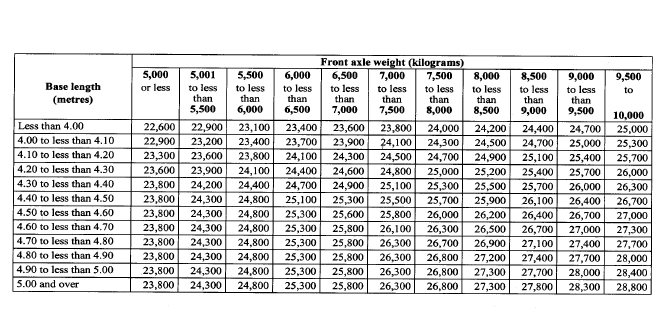
O. Reg. 413/05, Table 1.
VEHICLE WEIGHT TABLE 2
ALLOWABLE GROSS WEIGHT ON A VEHICLE WITH FOUR AXLES (KILOGRAMS)
FRONT AXLE WEIGHT, (KILOGRAMS)
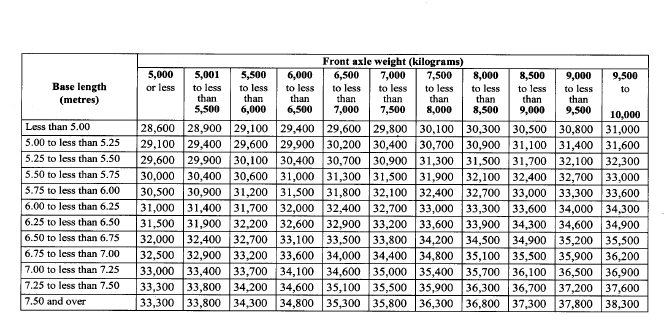
O. Reg. 413/05, Table 2.
VEHICLE WEIGHT TABLE 3
ALLOWABLE GROSS WEIGHT ON A VEHICLE WITH FIVE AXLES (KILOGRAMS)
INTER-VEHICLE-UNIT DISTANCE, LESS THAN 2.4 METRES
(OR INTRA-VEHICLE-UNIT DISTANCE)
FRONT AXLE WEIGHT, (KILOGRAMS)
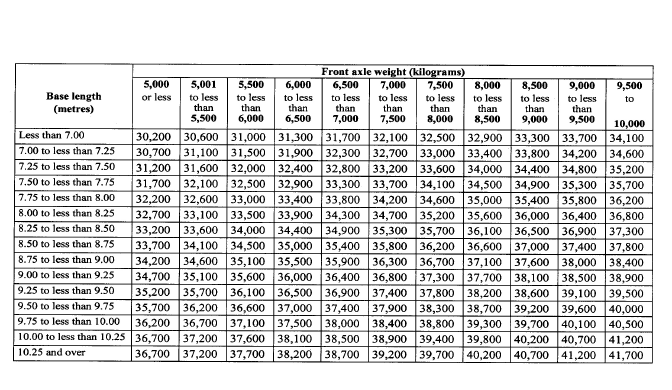
O. Reg. 413/05, Table 3.
VEHICLE WEIGHT TABLE 4
ALLOWABLE GROSS WEIGHT ON A VEHICLE WITH FIVE AXLES (KILOGRAMS)
INTER-VEHICLE-UNIT DISTANCE, 2.4 METRES TO LESS THAN 2.7 METRES
(OR INTRA-VEHICLE-UNIT DISTANCE)
FRONT AXLE WEIGHT, (KILOGRAMS)
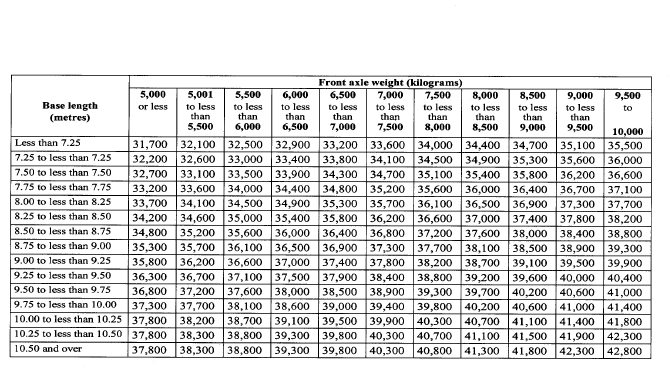
O. Reg. 413/05, Table 4.
VEHICLE WEIGHT TABLE 5
ALLOWABLE GROSS WEIGHT ON A VEHICLE WITH FIVE AXLES (KILOGRAMS)
INTER-VEHICLE-UNIT DISTANCE, 2.7 METRES TO LESS THAN 3.0 METRES
(OR INTRA-VEHICLE-UNIT DISTANCE)
FRONT AXLE WEIGHT, (KILOGRAMS)
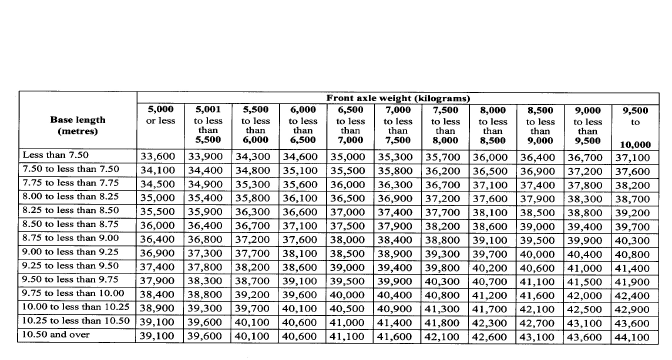
O. Reg. 413/05, Table 5.
VEHICLE WEIGHT TABLE 6
ALLOWABLE GROSS WEIGHT ON A VEHICLE WITH FIVE AXLES (KILOGRAMS)
INTER-VEHICLE-UNIT DISTANCE, 3.0 METRES TO LESS THAN 3.3 METRES
(OR INTRA-VEHICLE-UNIT DISTANCE)
FRONT AXLE WEIGHT, (KILOGRAMS)
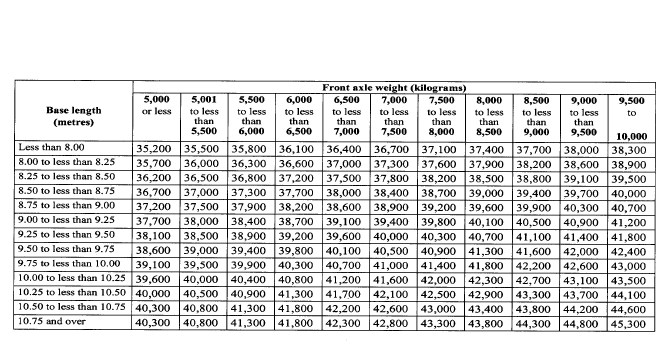
O. Reg. 413/05, Table 6.
VEHICLE WEIGHT TABLE 7
ALLOWABLE GROSS WEIGHT ON A VEHICLE WITH FIVE AXLES (KILOGRAMS)
INTER-VEHICLE-UNIT DISTANCE, 3.3 METRES TO LESS THAN 3.6 METRES
(OR INTRA-VEHICLE-UNIT DISTANCE)
FRONT AXLE WEIGHT, (KILOGRAMS)
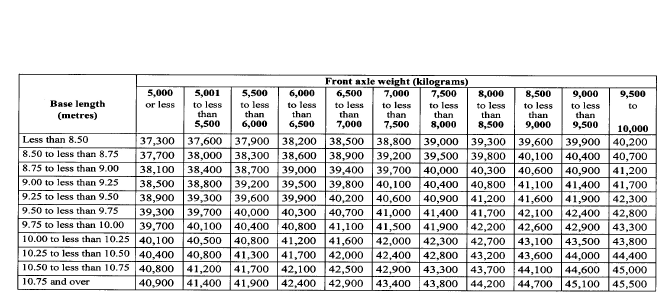
O. Reg. 413/05, Table 7.
VEHICLE WEIGHT TABLE 8
ALLOWABLE GROSS WEIGHT ON A VEHICLE WITH FIVE AXLES (KILOGRAMS)
INTER-VEHICLE-UNIT DISTANCE, 3.6 METRES OR MORE
(OR INTRA-VEHICLE-UNIT DISTANCE)
FRONT AXLE WEIGHT, (KILOGRAMS)
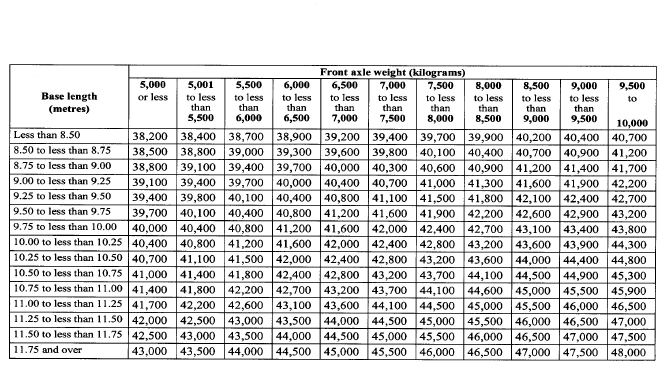
O. Reg. 413/05, Table 8.
VEHICLE WEIGHT TABLE 9
ALLOWABLE GROSS WEIGHT ON A VEHICLE WITH SIX AXLES (KILOGRAMS)
INTER-VEHICLE-UNIT DISTANCE, LESS THAN 2.1 METRES
(OR INTRA-VEHICLE-UNIT DISTANCE)
FRONT AXLE WEIGHT, (KILOGRAMS)
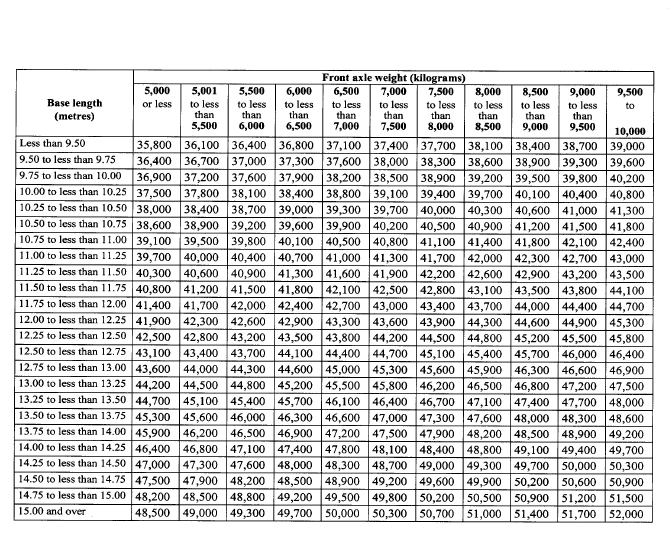
O. Reg. 413/05, Table 9.
VEHICLE WEIGHT TABLE 10
ALLOWABLE GROSS WEIGHT ON A VEHICLE WITH SIX AXLES (KILOGRAMS)
INTER-VEHICLE-UNIT DISTANCE, 2.1 METRES TO LESS THAN 2.4 METRES
(OR INTRA-VEHICLE-UNIT DISTANCE)
FRONT AXLE WEIGHT, (KILOGRAMS)
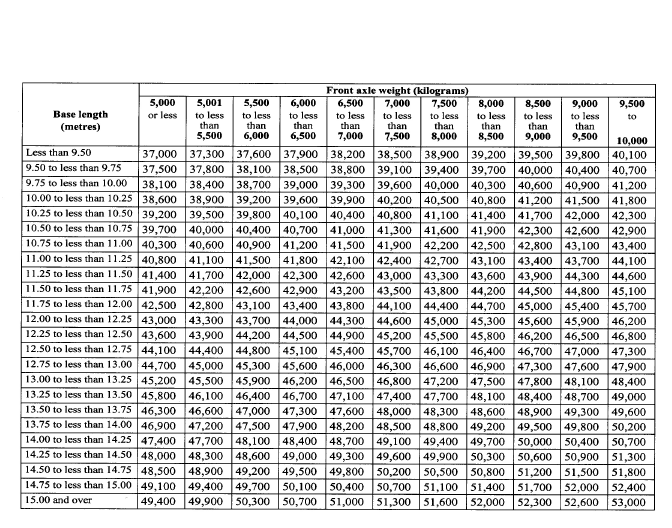
O. Reg. 413/05, Table 10.
VEHICLE WEIGHT TABLE 11
ALLOWABLE GROSS WEIGHT ON A VEHICLE WITH SIX AXLES (KILOGRAMS)
INTER-VEHICLE-UNIT DISTANCE, 2.4 METRES TO LESS THAN 2.7 METRES
(OR INTRA-VEHICLE-UNIT DISTANCE)
FRONT AXLE WEIGHT, (KILOGRAMS)
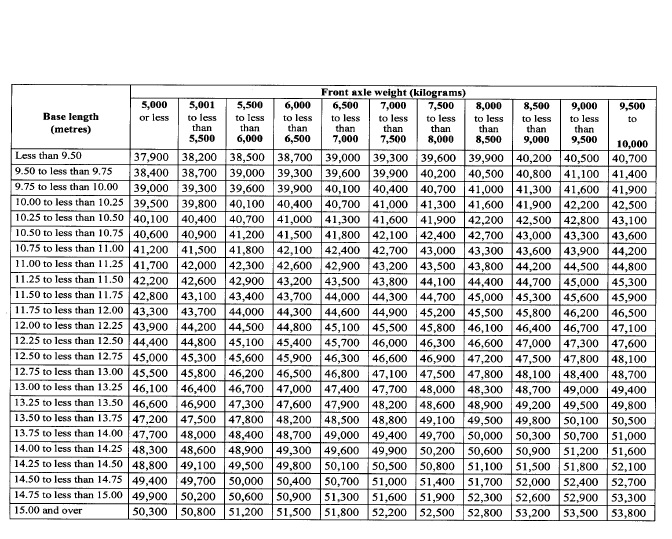
O. Reg. 413/05, Table 11.
VEHICLE WEIGHT TABLE 12
ALLOWABLE GROSS WEIGHT ON A VEHICLE WITH SIX AXLES (KILOGRAMS)
INTER-VEHICLE-UNIT DISTANCE, 2.7 METRES TO LESS THAN 3.0 METRES
(OR INTRA-VEHICLE-UNIT DISTANCE)
FRONT AXLE WEIGHT, (KILOGRAMS)
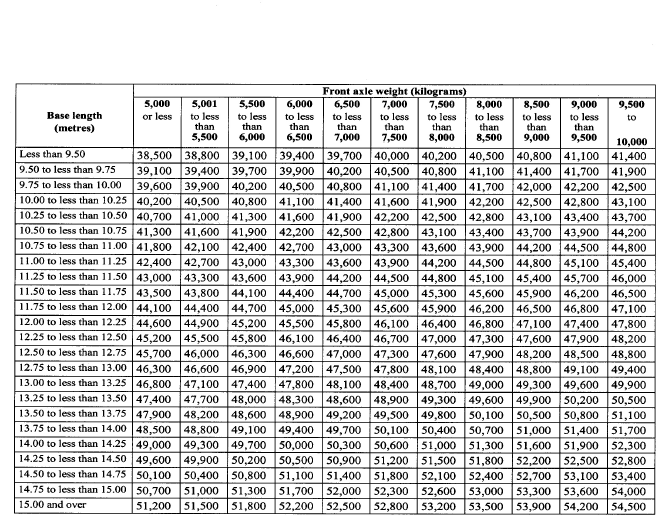
O. Reg. 413/05, Table 12.
VEHICLE WEIGHT TABLE 13
ALLOWABLE GROSS WEIGHT ON A VEHICLE WITH SIX AXLES (KILOGRAMS)
INTER-VEHICLE-UNIT DISTANCE, 3.0 METRES TO LESS THAN 3.3 METRES
(OR INTRA-VEHICLE-UNIT DISTANCE)
FRONT AXLE WEIGHT, (KILOGRAMS)
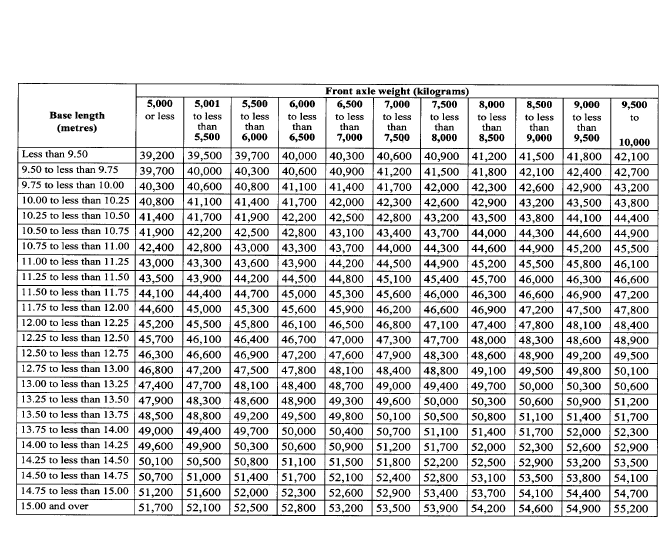
O. Reg. 413/05, Table 13.
VEHICLE WEIGHT TABLE 14
ALLOWABLE GROSS WEIGHT ON A VEHICLE WITH SIX AXLES (KILOGRAMS)
INTER-VEHICLE-UNIT DISTANCE, 3.3 METRES TO LESS THAN 3.6 METRES
(OR INTRA-VEHICLE-UNIT DISTANCE)
FRONT AXLE WEIGHT, (KILOGRAMS)
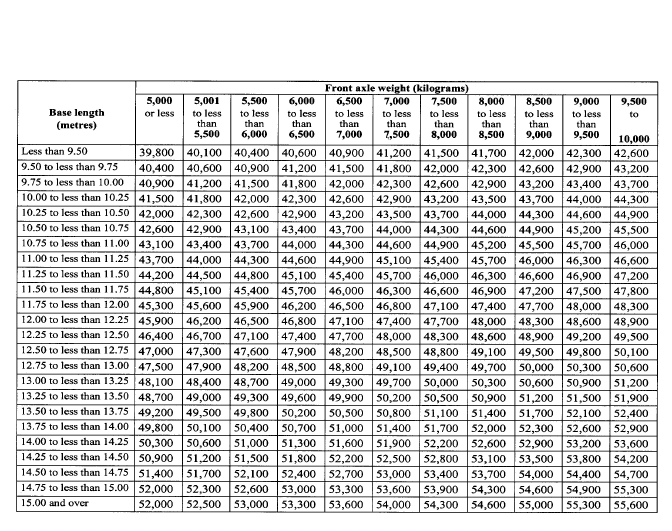
O. Reg. 413/05, Table 14.
VEHICLE WEIGHT TABLE 15
ALLOWABLE GROSS WEIGHT ON A VEHICLE WITH SIX AXLES (KILOGRAMS)
INTER-VEHICLE-UNIT DISTANCE, 3.6 METRES OR MORE
(OR INTRA-VEHICLE-UNIT DISTANCE)
FRONT AXLE WEIGHT, (KILOGRAMS)
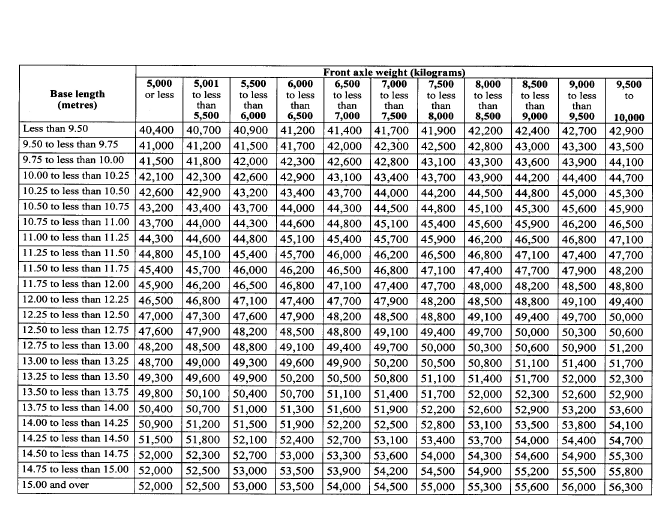
O. Reg. 413/05, Table 15.
VEHICLE WEIGHT TABLE 16
ALLOWABLE GROSS WEIGHT ON A VEHICLE WITH SEVEN AXLES (KILOGRAMS)
INTER-VEHICLE-UNIT DISTANCE, LESS THAN 2.1 METRES
FRONT AXLE WEIGHT, (KILOGRAMS)
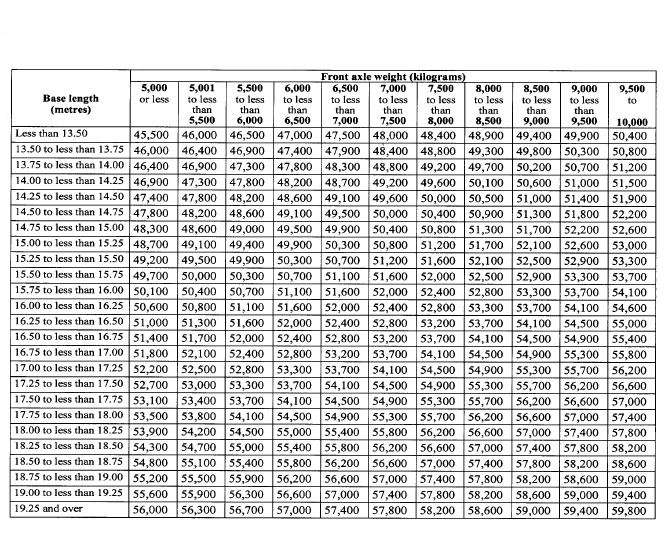
O. Reg. 413/05, Table 16.
VEHICLE WEIGHT TABLE 17
ALLOWABLE GROSS WEIGHT ON A VEHICLE WITH SEVEN AXLES (KILOGRAMS)
INTER-VEHICLE-UNIT DISTANCE, 2.1 METRES TO LESS THAN 2.4 METRES
FRONT AXLE WEIGHT, (KILOGRAMS)
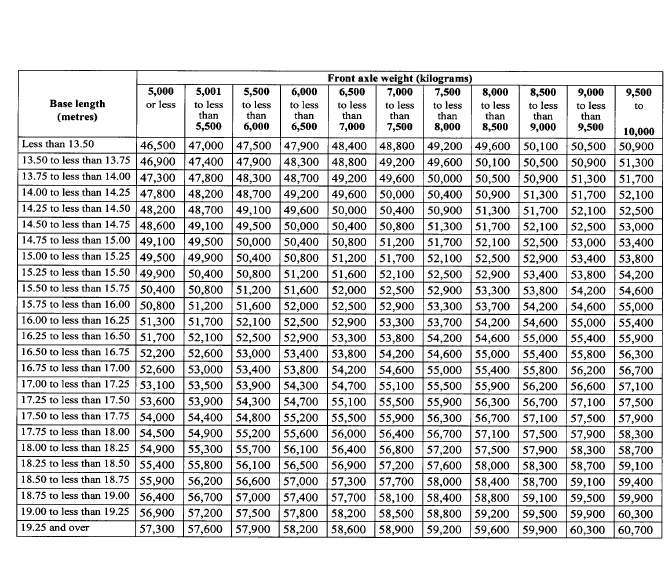
O. Reg. 413/05, Table 17.
VEHICLE WEIGHT TABLE 18
ALLOWABLE GROSS WEIGHT ON A VEHICLE WITH SEVEN AXLES (KILOGRAMS)
INTER-VEHICLE-UNIT DISTANCE, 2.4 METRES TO LESS THAN 2.7 METRES
FRONT AXLE WEIGHT, (KILOGRAMS)
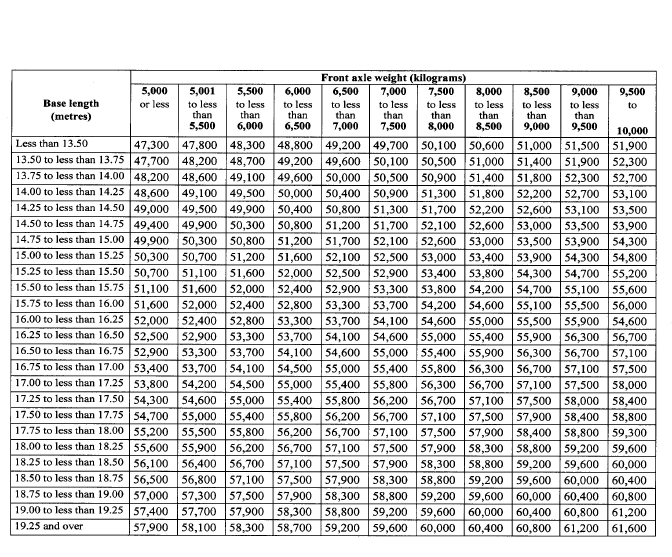
O. Reg. 413/05, Table 18.
VEHICLE WEIGHT TABLE 19
ALLOWABLE GROSS WEIGHT ON A VEHICLE WITH SEVEN AXLES (KILOGRAMS)
INTER-VEHICLE-UNIT DISTANCE, 2.7 METRES TO LESS THAN 3.0 METRES
FRONT AXLE WEIGHT, (KILOGRAMS)
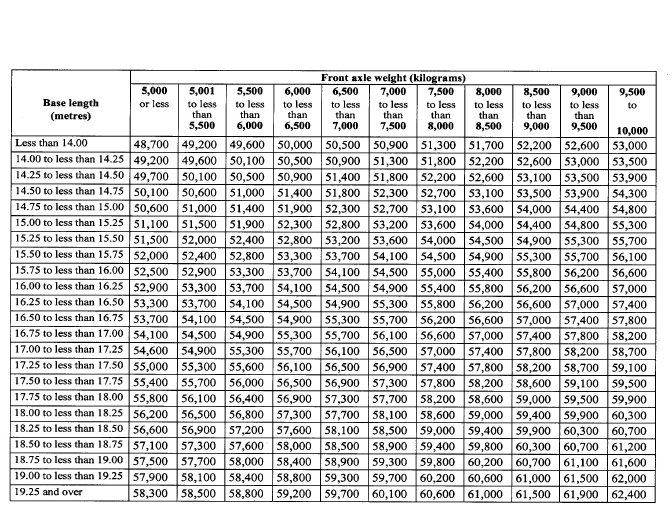
O. Reg. 413/05, Table 19.
VEHICLE WEIGHT TABLE 20
ALLOWABLE GROSS WEIGHT ON A VEHICLE WITH SEVEN AXLES (KILOGRAMS)
INTER-VEHICLE-UNIT DISTANCE, 3.0 METRES TO LESS THAN 3.3 METRES
FRONT AXLE WEIGHT, (KILOGRAMS)
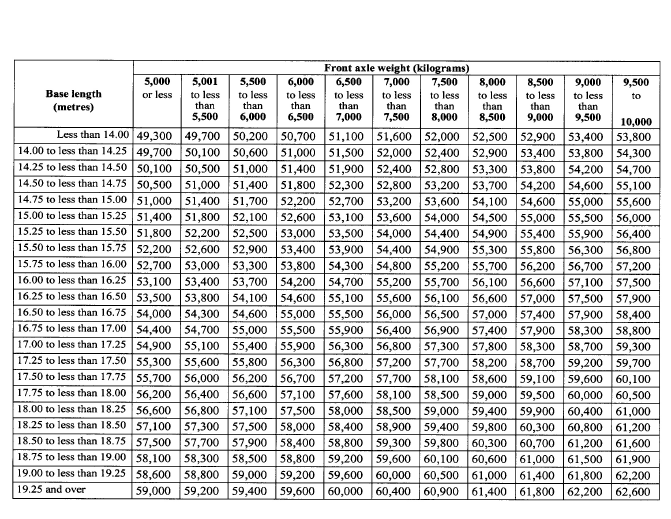
O. Reg. 413/05, Table 20.
VEHICLE WEIGHT TABLE 21
ALLOWABLE GROSS WEIGHT ON A VEHICLE WITH SEVEN AXLES (KILOGRAMS)
INTER-VEHICLE-UNIT DISTANCE, 3.3 METRES TO LESS THAN 3.6 METRES
FRONT AXLE WEIGHT, (KILOGRAMS)
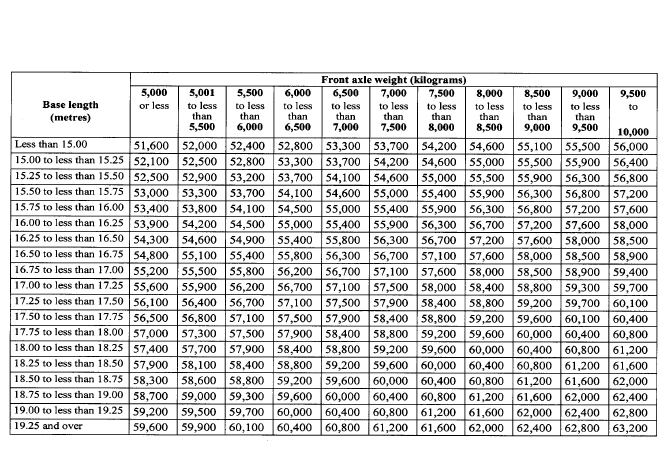
O. Reg. 413/05, Table 21.
VEHICLE WEIGHT TABLE 22
ALLOWABLE GROSS WEIGHT ON A VEHICLE WITH SEVEN AXLES (KILOGRAMS)
INTER-VEHICLE-UNIT DISTANCE, 3.6 METRES OR MORE
FRONT AXLE WEIGHT, (KILOGRAMS)
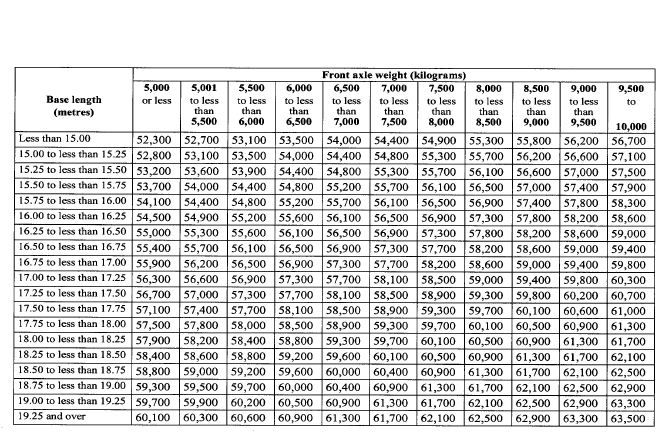
O. Reg. 413/05, Table 22.
VEHICLE WEIGHT TABLE 23
ALLOWABLE GROSS WEIGHT ON A VEHICLE WITH EIGHT OR MORE AXLES (KILOGRAMS)
INTER-VEHICLE-UNIT DISTANCE, LESS THAN 2.1 METRES
FRONT AXLE WEIGHT, (KILOGRAMS)
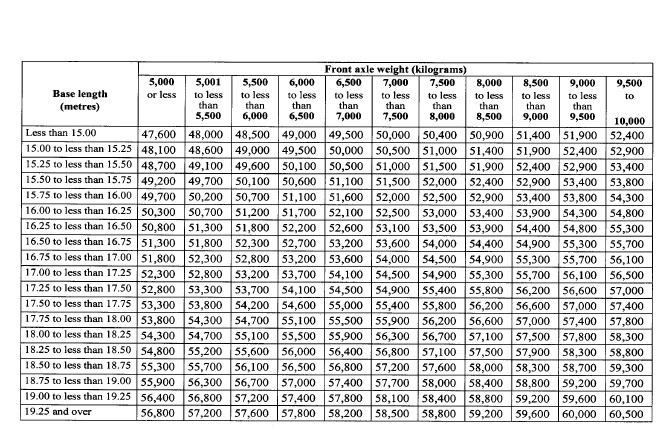
O. Reg. 413/05, Table 23.
VEHICLE WEIGHT TABLE 24
ALLOWABLE GROSS WEIGHT ON A VEHICLE WITH EIGHT OR MORE AXLES (KILOGRAMS)
INTER-VEHICLE-UNIT DISTANCE, 2.1 METRES TO LESS THAN 2.4 METRES
FRONT AXLE WEIGHT, (KILOGRAMS)
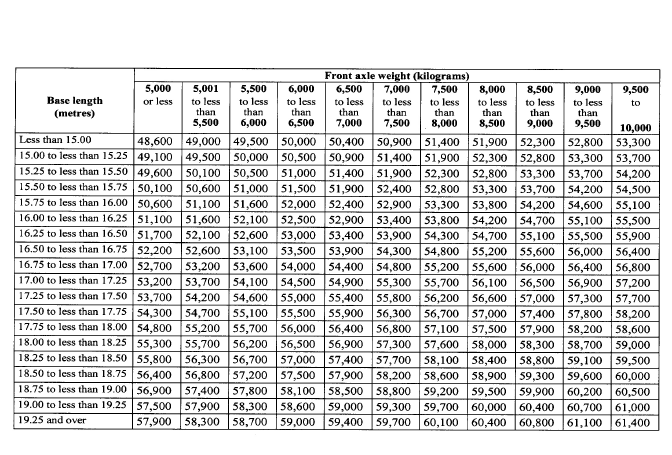
O. Reg. 413/05, Table 24.
VEHICLE WEIGHT TABLE 25
ALLOWABLE GROSS WEIGHT ON A VEHICLE WITH EIGHT OR MORE AXLES (KILOGRAMS)
INTER-VEHICLE-UNIT DISTANCE, 2.4 METRES TO LESS THAN 2.7 METRES
FRONT AXLE WEIGHT, (KILOGRAMS)
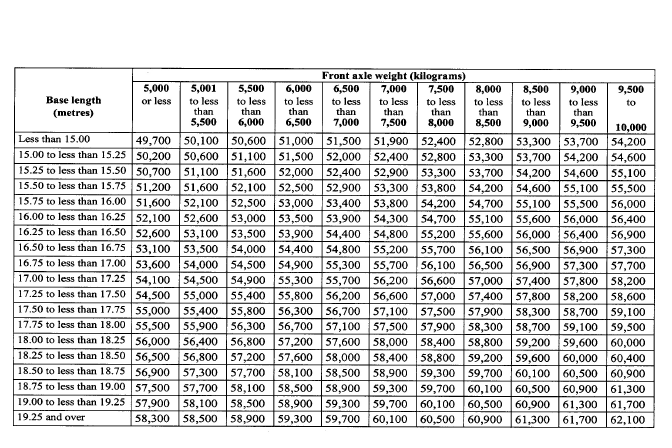
O. Reg. 413/05, Table 25.
VEHICLE WEIGHT TABLE 26
ALLOWABLE GROSS WEIGHT ON A VEHICLE WITH EIGHT OR MORE AXLES (KILOGRAMS)
INTER-VEHICLE-UNIT DISTANCE, 2.7 METRES TO LESS THAN 3.0 METRES
FRONT AXLE WEIGHT, (KILOGRAMS)
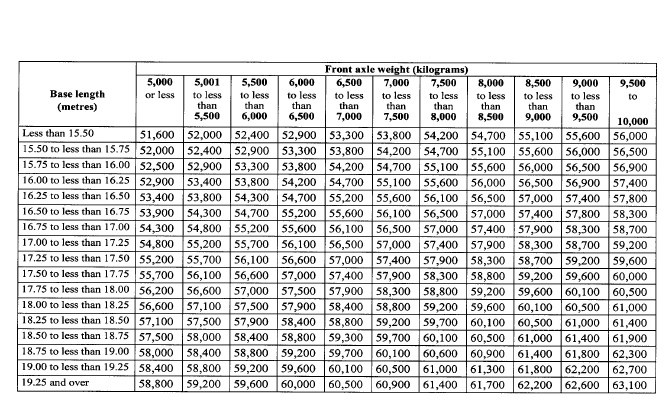
O. Reg. 413/05, Table 26.
VEHICLE WEIGHT TABLE 27
ALLOWABLE GROSS WEIGHT ON A VEHICLE WITH EIGHT OR MORE AXLES (KILOGRAMS)
INTER-VEHICLE-UNIT DISTANCE, 3.0 METRES TO LESS THAN 3.3 METRES
FRONT AXLE WEIGHT, (KILOGRAMS)
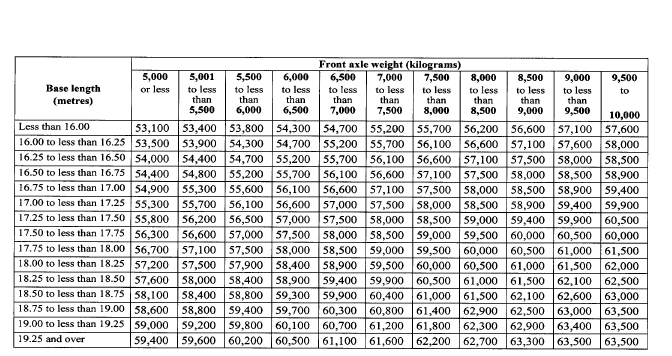
O. Reg. 413/05, Table 27.
VEHICLE WEIGHT TABLE 28
ALLOWABLE GROSS WEIGHT ON A VEHICLE WITH EIGHT OR MORE AXLES (KILOGRAMS)
INTER-VEHICLE-UNIT DISTANCE, 3.3 METRES TO LESS THAN 3.6 METRES
FRONT AXLE WEIGHT, (KILOGRAMS)
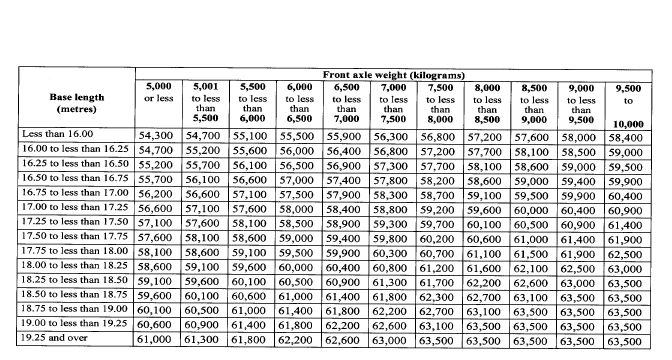
O. Reg. 413/05, Table 28.
VEHICLE WEIGHT TABLE 29
ALLOWABLE GROSS WEIGHT ON A VEHICLE WITH EIGHT OR MORE AXLES (KILOGRAMS)
INTER-VEHICLE-UNIT DISTANCE, 3.6 METRES OR MORE
FRONT AXLE WEIGHT, (KILOGRAMS)
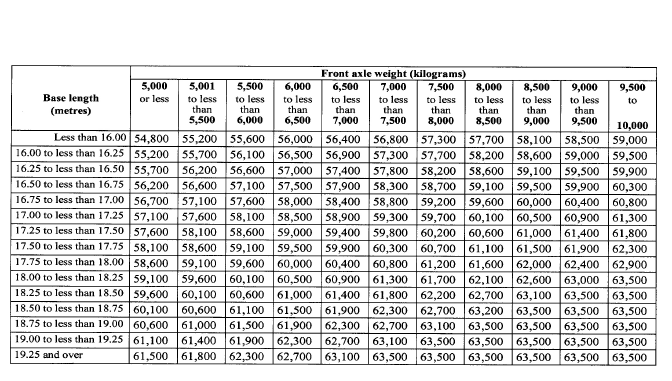
O. Reg. 413/05, Table 29.